




































Golf Kitchen Magazine is a quarterly publication of GK Partners LLC. Copyright 2023. Print subscriptions are available at golfkitchen.com for $75.00 per year. See QR codes on opposite page.
All rights reserved in all countries. Contents may not be reproduced in any manner without written permission of GK Partners LLC.
GK Partners LLC. does not necessarily agree with the viewpoints expressed by our contributing writers of articles and advertising copy.
For advertising / brand opportunities please email: chrisb@golfkitchen.com
Golf Kitchen welcomes letters to the founder at diana@golfkitchen.com




I am proud to have affiliated with new partners who will help me take the Golf Kitchen brand to the next level: Hunter Public Relations (Karen Moraghan), GEM Advertising (Christopher Bartlett), and JM Media (Gary Doyens).
Each themed, quarterly edition will have enhanced distribution and will be strategically supported by select advertisers. Special thanks to Chefs Warehouse and HAFSCO for stepping to the plate for this issue.
Fittingly, we launch with the theme of philanthropy to illustrate the generosity of the golf industry and the many club events that support charities.
Our cover feature showcases “Taste of Golf” an annual event held at TPC Sawgrass, Ponte Vedra Beach, Florida and coordinated by Tory Eulenfield of the National Golf Course Restaurant Association (NGCRA) in support of First Tee (North Florida Chapter).
Other articles include the Berenberg Invitational, held at GlenArbor Golf Club, Bedford Hills, New York, which is raising funds to find a cure for pancreatic cancer, and an overview of a new alliance between ClubsHelp, which rallies clubs around the country in support of worthy causes in their communities, and Eagles for Children.
No issue of Golf Kitchen would be complete without a notable chef profile and in-depth wine reviews by Fernando Silva, sommelier and artist. Other stories cover the growth of craft whiskey, Chef Z’s take on international street food, and an enticing Italy travel showcase to set the stage for the 2023 Ryder Cup. I hope you’ll enjoy my personal photo essay on the value of quality food photography in the private club industry.
Please savor this issue—your continued input and support is valued.
Warmest personal regards,
 Diana DeLucia Founder and Editor
Diana DeLucia Founder and Editor






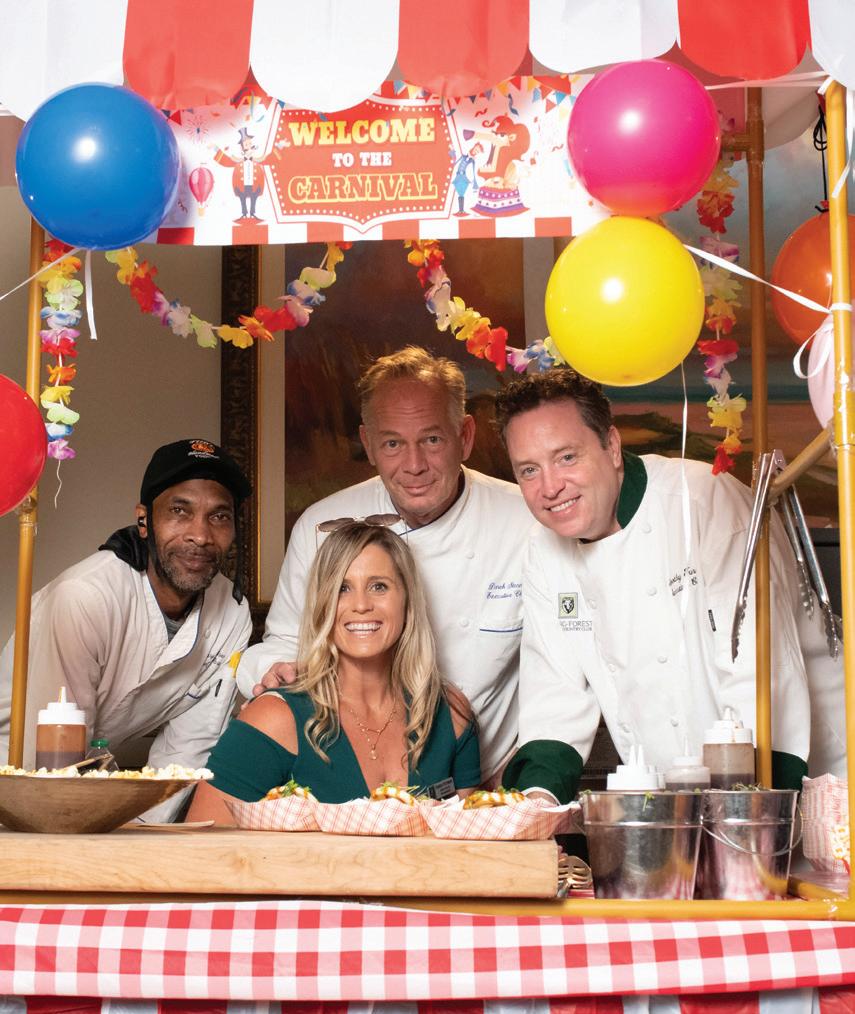
60

TAKING IT TO THE STREETS WITH CHEF Z
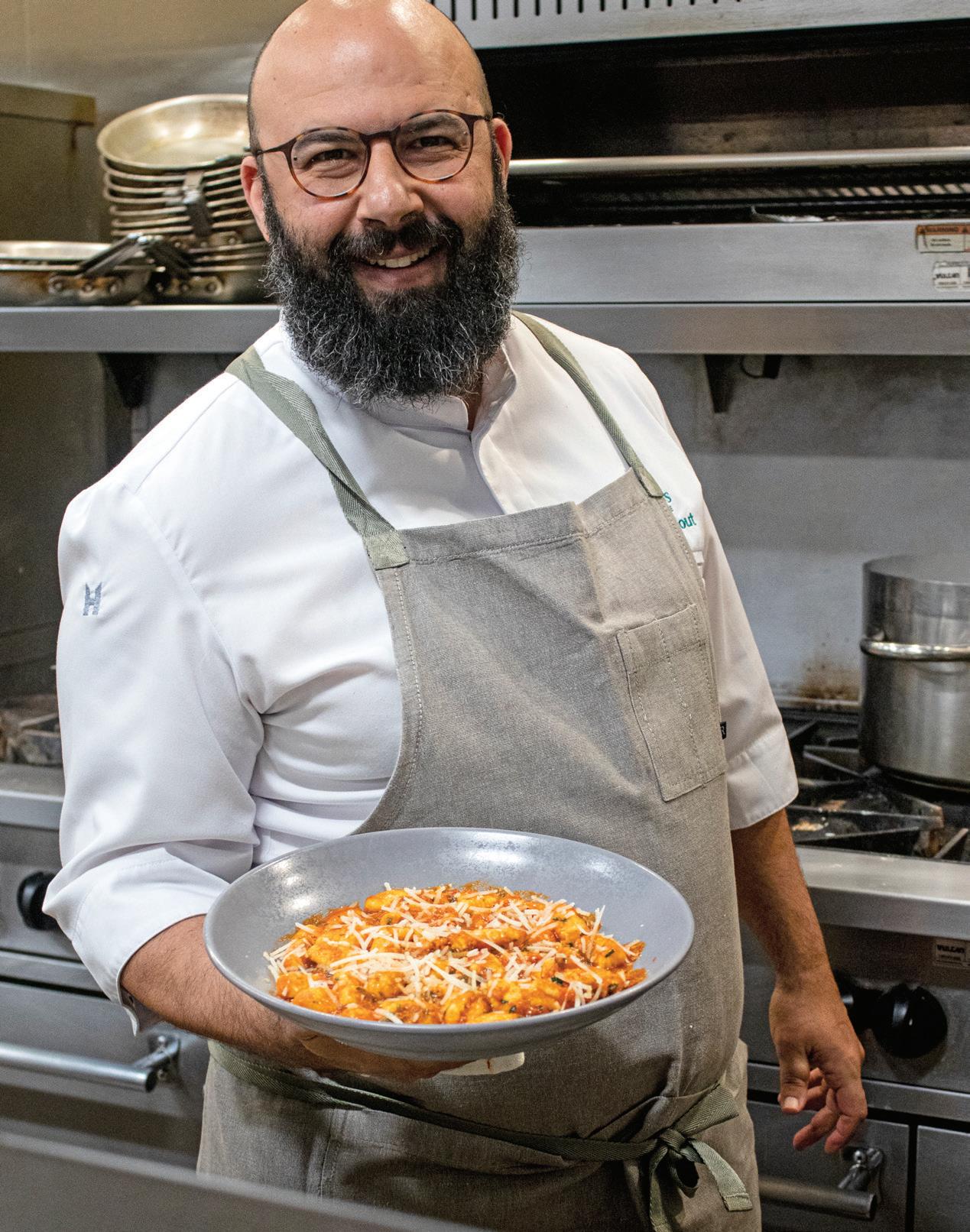
Driven by the mission to help the health of all people, Chef Ming Tsai created Mings Bings and donates a portion of proceeds to Family Reach and Dana-Farber Cancer Institute and the Jimmy Fund
These delicious, plant-based pockets put a 21st century spin on traditional Chinese flatbread. Tsai says, “Food is medicine for the body and soul, so I choose foods that support my immune system, lower inflammation, and help me live a longer, fuller life.”

For food connoisseurs, buying food that appeals to our taste buds and our philanthropic desires is a win-win proposition. Many companies are dedicated to supporting charitable causes through sales of food products and by donating a portion of the proceeds to worthy charities. Our purchasing power can inspire global change, make a difference, and support a wide variety of causes.
In 1982, Paul Newman’s vision was to create a quality food and beverage company dedicated to philanthropy. Promising that 100% of the profits would go to charity, since that time the Newman’s Own Foundation has donated over $600 million to various charities. From snacks to salad dressings, Newman’s offers a wide range of products to give all consumers a chance at making a change, with a particular emphasis on nourishing and transforming the lives of children who face adversity.

Endangered Species Chocolate donates 10% of their net profits to various endangered species foundations. Their dark chocolate barks and chocolate spreads are delectable, especially because of their contribution to global change.

Discover
you
Operation BBQ Relief is a 501(c)(3) nonprofit organization that supports communities following natural disasters with hot barbeque meals to those in need and on the front lines. After the devastating tornado in Joplin, Mo. in May 2011, competitive pit masters from eight different states answered the call to feed displaced families and first responders, and served over 120,000 meals over 13 days. This experience was the catalyst that started what Operation BBQ Relief is today. With the help of more than 14,000 volunteers, Operation BBQ Relief has provided over 9 million meals throughout the United States. In response to the COVID-19 pandemic, the organization has provided over four million meals to first responders, medical workers, veterans, families, and organizations affected by the pandemic. In 2017, Stan Hays, CEO and Co-Founder was recognized as one of the “CNN Heroes” for his work with Operation BBQ Relief.


Hot sauce with a mission… Bring the world into your kitchen and be part of a solution. One bottle at a time, Clark & Hopkins donates $1 from every purchase to World Central Kitchen and to help rebuild community in Ukraine.
For wine lovers who adore canines, Rascal Wines are made for dog lover by dog lovers. Rascal is one of the fastest growing brands from Oregon’s Willamette Valley. Sales of the company’s Pinot Noir, Rose, and Chardonnay support The Humane Society of America, whose logo appears on every bottle alongside the silhouette of a dog.

I first met Thomas Isidori when I visited Brae Burn Country Club in Purchase, New York for a food photography assignment. The vast clubhouse has two enormous kitchens and on this day there was a member/guest tournament being serviced by the catering team. In the second kitchen and dining areas, Chef Thomas and I had our own private set for preparing dishes and shooting the images that accompany this profile. For me, this was total bliss.
Please enjoy learning about the life of this emotionally and intellectually curious chef.
~ Diana DeLuciaGK: Tell us where you grew up and when your interest in cooking emerged.
TI: I was born in Yonkers, New York, and I am a third-generation chef in my family. My grandmother, Philomena aka Fanny, was a chef and owned a restaurant with my grandfather, Arthur, Villanova, on 47th Street in New York City. My father, Thomas Isidori Sr., owned a few restaurants in Westchester County, New York and Fairfield County, Connecticut. My uncles, Arthur and Donald also were chefs, and my “brother,” Joseph Isidori, is a successful Michelin star chef. Joe is my first cousin, but I call him my brother as we grew up together in the same three-family house. We are from divorced families, so we spent every Sunday cooking with our fathers—it was our quality, family time.
When I was in high school, I discovered that I wanted to cook for a living. I was accepted to the Massachusetts Institute of Technology (MIT) and planned to study architecture as I loved design. From my perspective, there is little difference in designing a plate or a building, and I like the instant gratification and feedback in the culinary world. I switched paths and enrolled at the Culinary Institute of America (CIA) in Hyde Park, New York, graduating in 1994. During my internship year, I was assigned to work at the Waldorf Astoria in Manhattan, but the chef there had no recollection of having me assigned to him, nor did he have space for me either. So, I returned to the CIA to look for an alternative location and subsequently contacted Ardsley Country Club. Executive Chef Victor Boyd was sympathetic to my situation and told me, “You can start tomorrow!” I jumped on the train, began my country club career, stayed at Ardsley for four years, and
have never left.
From there, I worked for Kevin Sullivan, Executive Chef at Innis Arden Golf Club, Old Greenwich, Connecticut, for seven years. Victor taught me how to be organized and fast, and Kevin taught me all the ins and outs of being an executive chef, including the necessary computer skills. From his example, I learned how to delegate and how to be a better manager. These two guys were the biggest influences on my career.
In 2001 I accepted my first executive chef position at the Stamford Yacht Club. For four years, I learned about high volume catering operation, which is significantly different from golf club culinary operations. At a yacht club, the money is on the water and invested in the owners’ boats. At golf clubs, members are invested in the club, the course, clubhouse, and other facilities. The models are very different.
Golf and country clubs are where I wanted to work and when I landed the executive chef role at the Country Club of Fairfield, the sixth-finest links course in the United States, I stayed for over a decade.
Two years ago, when I was offered the executive chef role at Brae Burn Country Club, a high-volume club where I could utilize and integrate all my experiences, I seized the opportunity.
TI: I have taught culinary classes at Norwalk Community College, Norwalk, Connecticut, for the last 15 years, including Food Introduction One, Cost Control and Production, Catering, and Event Management. My favorite class is International Cuisine, which I teach every Tuesday on my day off from the club.
GK: You are a very kind chef who gives back to the community. Could you tell us about that?
TI: I will do whatever I can for the community. When I was a member of the Club Chefs of Connecticut, we worked on the Stamford Hospital Foundation event for the kids everyyear. I was honored to oversee that event for four years, along with Jeff Perez, who is currently at Fairview Country Club.
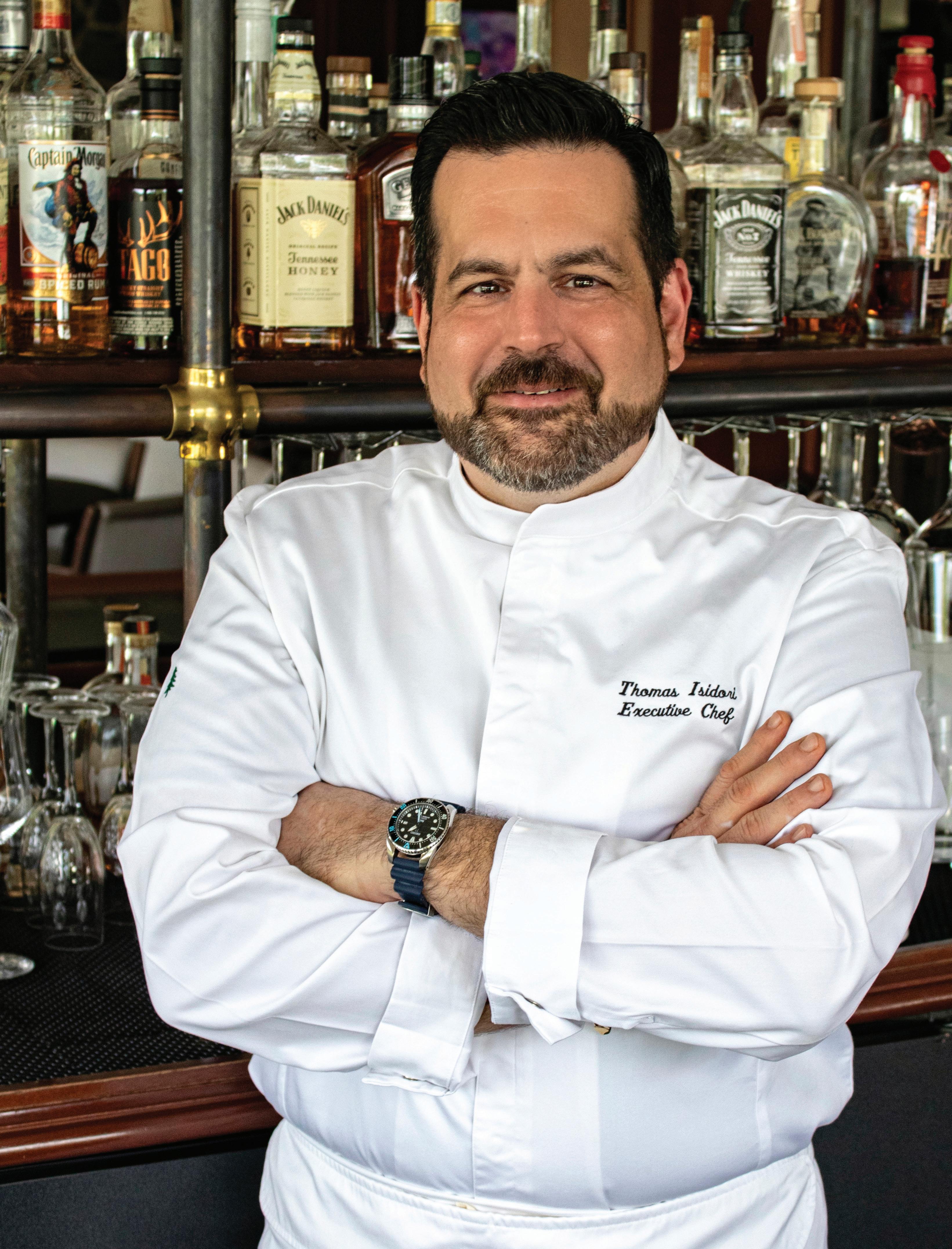
I live in Newtown, Connecticut and have a soft spot for this community, which reminds me of true America in the middle of this crazy world. In the town center is a massive flagpole where our patriotism is displayed each day. The community is open and kind, with very little crime. But as everyone knows, we had a life-altering tragedy in 2012 when a mass shooting took 26 lives, including 20 children who were only five and six years old.
In the aftermath, I coordinated and prepared meals for all the services and funerals. I reached out to the community and fellow chefs. Between purveyors, chefs, students, and the Country Club of Fairfield (which gave me the week off to work on the community’s behalf), we produced over 14,000 meals for first responders, volunteers, and families. This was one of the proudest moments of my career. Chefs reached out to me from Texas, Arizona, and California, offering their assistance, including one chef who drove non-stop from Atlanta and worked 48 hours straight. He was so passionate about supporting these people in their time of need.
The most emotional part for me was learning more about the children and what they wanted to be when they grew up. New York City sent three firetrucks to honor one of the little boys as he dreamed of being a fireman. They gave him a fireman’s burial. His small casket was on the back of a firetruck with firefighters and bagpipers lining the streets. It was the most heartfelt thing I have ever seen. It was the hardest thing I have ever done, but also the most rewarding. Each December 14 is a somber day for me.
GK: Tell us about your interest in watches.
TI: I have a large collection of Rolex, Panerai, and Omega watches. After the Newtown tragedy, I gave up my hunting rifle and started fixing and building watches, which occupies me in the off season.
GK: Did you have any expectations when you started at Brae Burn Country Club?
TI: When Brae Burn contacted me, the timing was great. As both a high volume and a Jewish club, I found there a membership that wanted an enhanced culinary program. Initially, I thought it would be much harder to turn this place around, but what they needed was an executive chef to provide direction.
GK: Tell us how your team works with the membership.
TI: My team has and shares their great ideas and through this collaborative environment, they’ve learned to trust me. Within six months, the club’s culinary program took off. Members were ecstatic. One day, I walked into my office and one member gifted me bottles of Tequila and Bourbon to thank us for the great meals and service.
I can experiment and introduce cool concepts. I challenge myself whenever we activate stations in the dining room, which is great for my staff as they are having great fun being creative. I love bringing the kitchen into the dining room and interacting with the members and guests. It has been a great experience here.
GK: You have two immaculate, large kitchens in the clubhouse, indicating a significant emphasis on food and beverage departments.
TI: Well, you know what they say, golf is about the golf and then, there’s everything else. Here at Brae Burn, the food comes before anything else!
GK: Being an Italian, tell us about your love of pasta and pizza.
TI: Nothing is more exciting to me than a hot pizza right out of the oven, especially when it looks like lava: you get the crispiness of the crust, the cheese, and the sauce; it’s a complete pleasure food and yet so simple. I hope that one day Joe and I can venture together and open an amazing pizzeria.
We make every kind of pasta in-house with my Sous Chefs Lucie, Spencer, and Javier, who has been with me for 17 years and 3 clubs now. The members love it. They enjoy seeing pizza made right in front of them and having us run an amazing pasta station with an array of fresh pasta.
GK: Tell us about your team.
TI: I truly believe we are a family and I know that I have some of the most incredible staff here at Brae Burn. And, I realize that my success here wouldn’t have happened without their hard work and dedication.
Nobody is treated inferior. I want to know what they are thinking and what ideas they would like to try. The one empowerment I give line employees is input on menus. This provides some ownership and encourages them to be successful. An example, if a junior sous chef comes to me with an idea, I ask him how he plans to implement it, then I provide feedback. Recently, based on a team member’s suggestion, we created an oyster action station four ways in the buffet and it was a huge hit.
I bought knife kits for each team member when I got here. Why do I give a chef’s knife kit to a dishwasher? As much as I personally hate doing dishes, it gives me so much pleasure to see an employee advance themselves whether it be moving up in my kitchen or leaving my kitchen for a higher position in another. I love seeing people grow and mature and become successful. I don’t want them to always be a dishwasher.

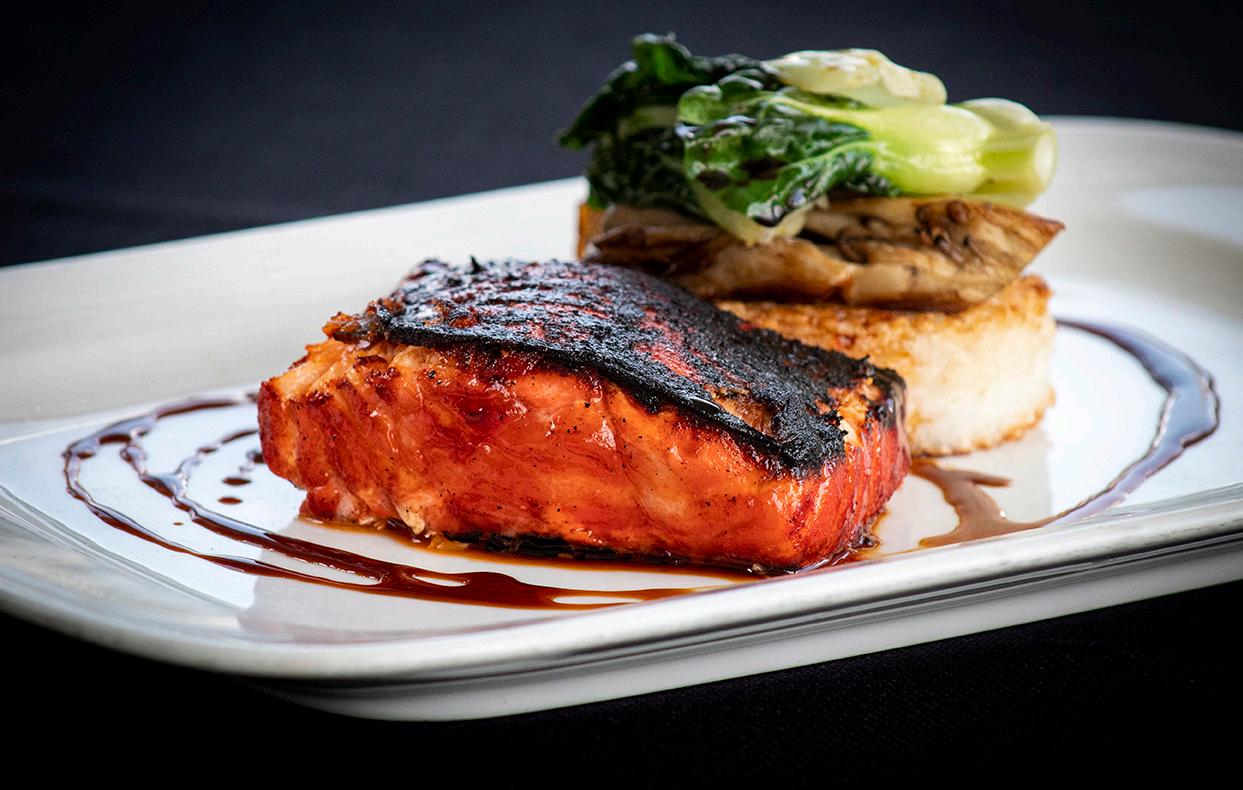 The Clubhouse at Brae Burn Country Club
Roasted Farroe Island Salmon with Char Shu glazed over Crisp Sushi Rice Cake, Baby Bok Choy and Grilled Oyster Mushrooms.
The Clubhouse at Brae Burn Country Club
Roasted Farroe Island Salmon with Char Shu glazed over Crisp Sushi Rice Cake, Baby Bok Choy and Grilled Oyster Mushrooms.
Yield: 4 portions
Plate Components
• Frittata
• Whipped Ricotta
• Edible flowers
• Petite Greens
Ingredients
Frittata
• olive oil to coat pans
• 16 eggs (cracked and whipped)
• 1/2 cup sour cream
• 1 cup parmesan cheese (divided)
• salt and pepper
• 16 tricolor grape tomatoes (halved)
• 16 ounces zucchini (grated and moisture squeezed out)
• 4 ounces wild mushrooms (cleaned, sliced, and roasted)
• 4 zucchini flowers chiffonade
Whipped Ricotta
• 12 ounces of Fresh Ricotta
• Salt and Pepper
• 1 teaspoon of Lemon Juice
• 1 Tablespoon Olive Oil
• 1/4 cup toasted pine nuts
Garnish
• petite greens (dressed with lemon oil)
• micro flowers
• flaked salt
• olive oil
Frittata
Prepare four 6 1/2 inch cast iron pans by brushing the inside with olive oil. Heat the oven to 325°F. Mix the eggs, sour cream, and half the parmesan cheese in a bowl and season with salt and pepper.
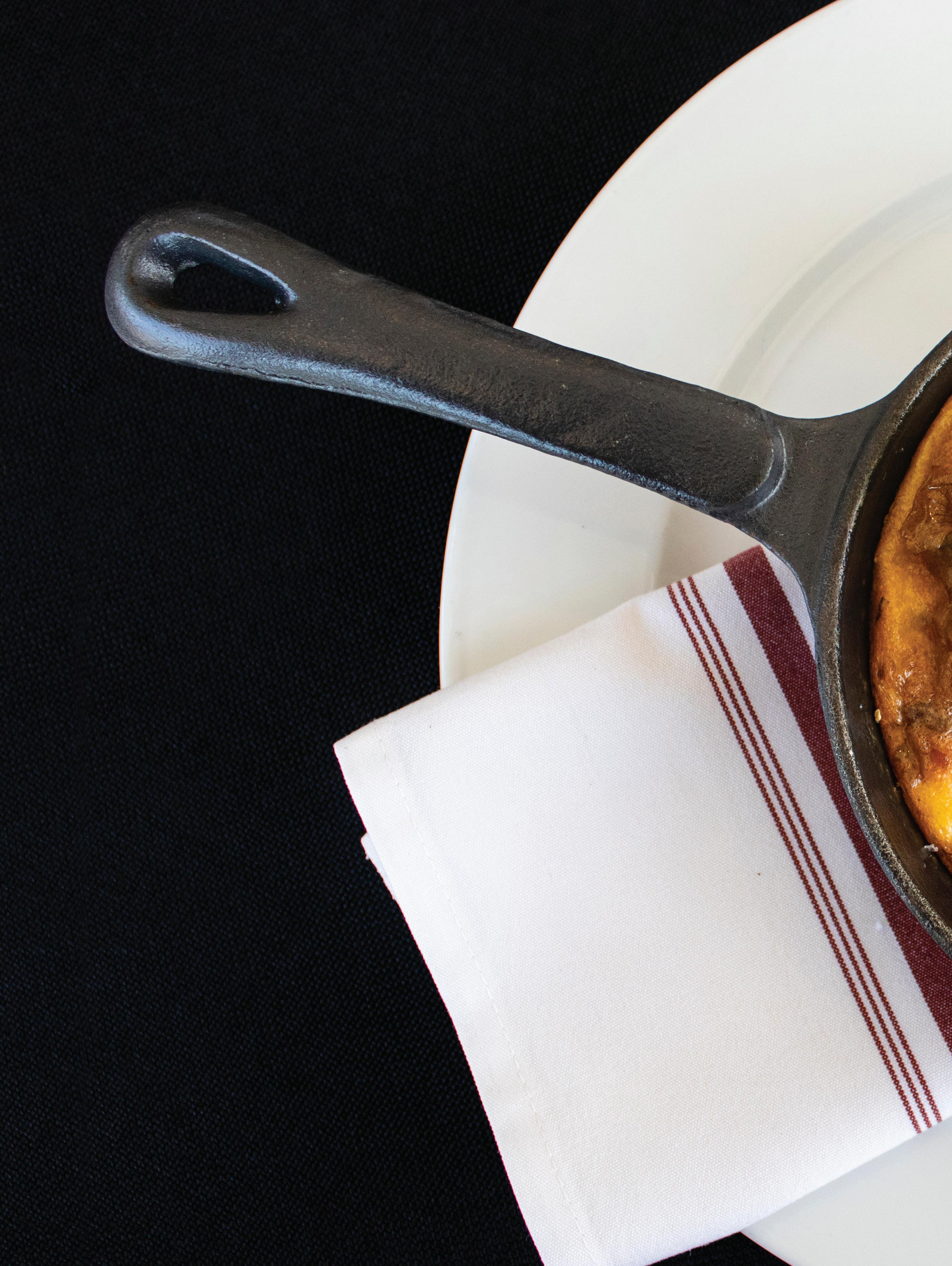


Summer Frittata continued…
In the bottom of each pan, arrange the tomatoes, zucchini, mushrooms, and zucchini flowers and season with salt and pepper. Pour the egg mixture over the top, sprinkle remaining parmesan on top, and place in the oven, checking and turning every 15 minutes until set. Remove from the oven and hold in a warm place.
Place the ricotta, salt and pepper, lemon juice, and olive oil in a food processor and whip until soft and light and the cheese has no lumps. Fold in the toasted pine nuts.
Place a kitchen towel folded in thirds on the plate. Place the cast-iron pan on top of the towel. Chef Note: You can use the plate of your choosing. Quenelle three ounces of the ricotta in the center of the frittata. Garnish with micro flowers and place petite greens next to the ricotta. Finish with flakes of salt and drizzle of olive oil.

Yields: 10-12
Squid Ink Pasta
• 1 bag (2.2 pounds) of Caputo Semola di Grano Duro
• 2 tablespoons kosher salt
• 1 tablespoon baking soda
• 3 tablespoons squid ink or Cuttlefish ink
• 1-1 1/2 cups San Pellegrino Water
San Marzano Sauce
• 1/4 cup olive oil
• 20 cloves sliced garlic
• 2 shallots (thinly sliced)
• pinch red pepper flakes
• 2 cups dry white wine
• 28 ounces san marzano tomatoes (hand crushed)
• salt and pepper (to taste)
• basil (chiffonade)
Seafood Mix
• 1/4 cup olive oil
• 12 each shrimp
• 1 lb bay scallops
• 1 lb calamari
• 24 each quantity Manilla clams
• 24 each mussels
Fried Basil Leaves
• 8 large green basil leaves (washed)
• 1-quart blended oil
• salt and pepper
Squid Ink Pasta
Add flour, salt, and baking soda to a pasta machine fitted with the Spaghetti Die. Mix 1 cup of San Pellegrino with the ink and slowly add it to the machine. Add more water as needed to achieve the dough consistency you desire, and mix for a total of 10 minutes. Chef Note: Allow dough to hydrate for 15 minutes before extruding.
San Marzano Sauce
Heat the oil, garlic, and shallots in a saucepan until golden brown. Add the pepper flakes and toast for 30 seconds. Deglaze with the white wine and reduce for one minute. Add the tomatoes, salt and pepper, reduce uncovered for 10 to 15 minutes, remove from the heat and stir in the chiffonade of basil.
Fried Basil Leaves
Heat the oil in a cast Iron pan to 325°F. Dry the basil leaves well on a paper towel and place them in the heated oil. Cook just until crisp about three minutes turning one time. Remove from the oil and place on paper towel and season with salt and pepper.
Place a 1/4 cup olive oil in a large sauté pan. Sear the shrimp and scallops and remove from the pan immediately. Next give the calamari a quick sear just to set it. Add the clams and mussels to the hot pan and sauté for two minutes. Deglaze the pan with one cup of white wine and reduce by half. Add 1/2 the San Marzano sauce, cover and let cook for three minutes. Drop your pasta into a pot of boiling salted water, add the seared seafood to the pot and cook an additional three minutes and remove from the heat leave covered. In another sauce pan add the remaining San Marzano sauce and three knobs of butter and the chiffonade of basil. Bring to a simmer and add the pasta and cook two more minutes.
Select your desired plate. Twirl the pasta with a sauté fork and place in the center of the plate. Arrange the cooked seafood around and over the pasta. Spoon some sauce over the top and garnish with the crisp basil.
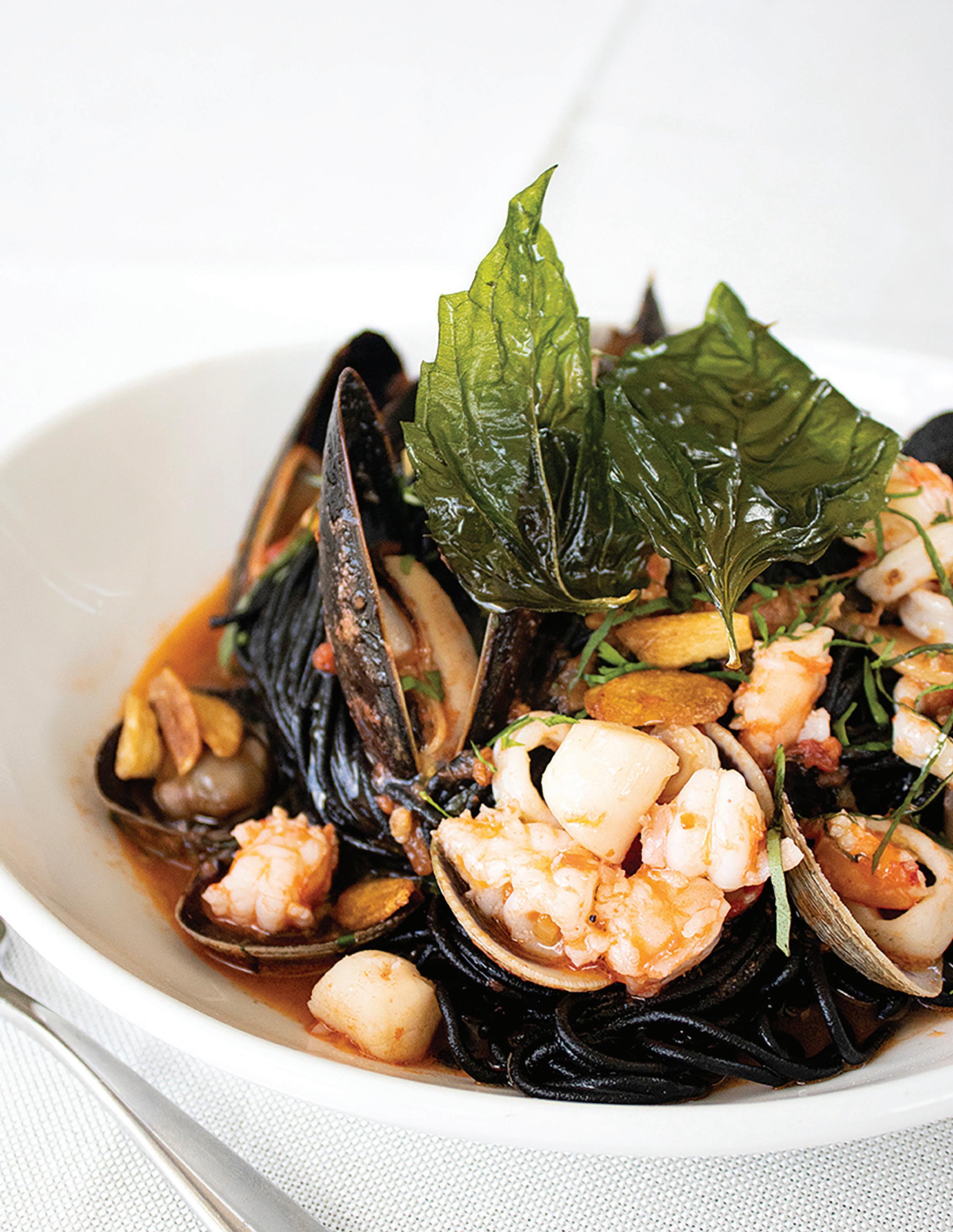
Yield: 4
• Cast Iron Seared Wagyu Denver Steak
• Whipped Potatoes
• Vegetable Medley
• Eel Sauce
• Chimichurri
• Crispy Shallots
Cast Iron Seared Wagyu Denver Steak
• 4 - 6 ounces Wagyu Denver Steaks (block cut and super trimmed)
• 1 cup soy sauce
• 1 cup olive oil
• 12 sprigs thyme (freshly picked)
• Salt and pepper (to taste)
Whipped Potatoes
• 1 pounds Yukon Gold potatoes (peeled and large diced)
• 1 pound Idaho russets (peeled and large diced)
• 1 1/2 cups whole milk
• 4 cloves garlic (smashed)
• 3 sprigs thyme (freshly picked)
• 4 ounces unsalted butter
• salt and pepper (to taste)
Vegetable Medley
• 1 zucchini (trim flesh, no seeds or middle, 1/4 inch slices)
• 1 yellow squash (trim flesh, no seeds or middle, 1/4 inch slices)
• 1 small butternut squash (peeled and medium diced)

• 2 carrots (peeled and oblique cut)
• 1 ounce butter
• 3 sprigs thyme (freshly picked)
• salt and pepper
Unagi (Eel Sauce)
• 1 cup tamari soy sauce
• 2/3 cup granulated sugar
• 1 cup mirin
• 1 cup saki
• 1 teaspoon Dashi crystals or powder
• 1 ounce rice wine vinegar
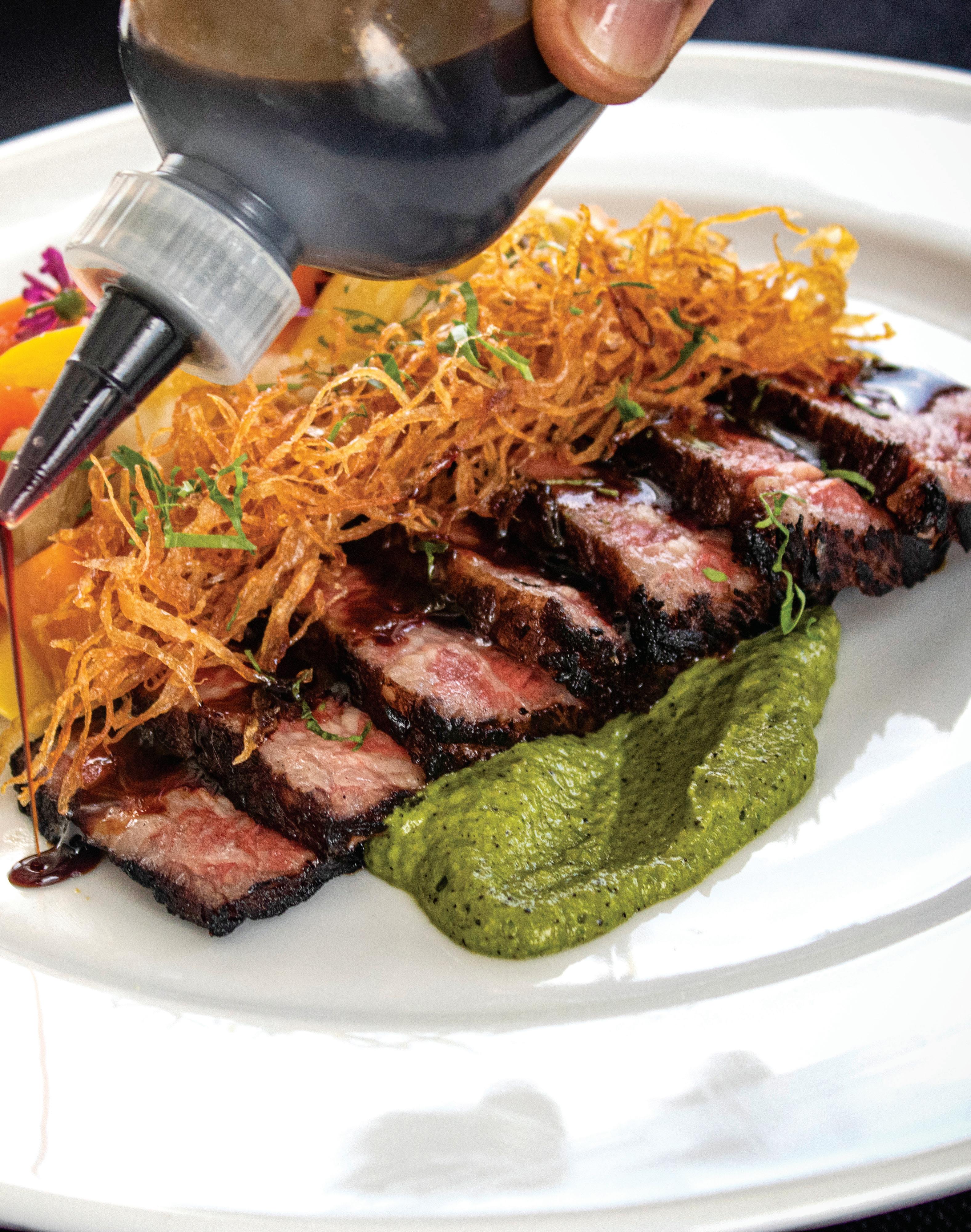
Truffle Chimichurri
• 1 bunch italian flat leaf parsley (washed and spun)
• 4 ounces truffle carpaccio or truffle peelings
• 2 ounces truffle oil
• 1 ounce rice wine vinegar
• 1 shallot (minced)
• salt and pepper (to taste)
• 1 clove garlic
Crisp Confit Shallots
• 15 whole shallots (peeled and sliced thin on a japanese mandoline)
• 3 quarts blended oil
• salt and pepper (to taste)
Garnish
• micro flowers
• chiffonade of parsley
Cast Iron Seared Wagyu Denver Steak
Super trim the Denver steak. Chef Note: You should be left with a portion approximately 2 inches x 4 inches. The cutting side should be the 2-inch side (against the grain). Place the meat in a bowl, add the soy sauce and olive oil (50 / 50), and season with fresh thyme and salt and pepper. Place each steak in a small-sized vacuum bag and vacuum pack. Let sit for 24 hours under refrigeration. Set up a circulator at 128°F, place the vacuumed sealed meat in, and leave it for 4 to 6 hours. Chef Note: If reserving for a later date, remove after 4 hours into an ice water bath for later service. Chef Note: If using at pick up, remove the bag from the circulator, cut open, remove meat to a sports towel, and pat dry. Hard sear on all 6 sides and let rest until serving.
Whipped Potatoes
Rinse the cut potatoes and place in an ample amount of water that has been well-salted. Bring to a simmer and cook for 12 minutes or until potatoes are soft. In a saucepan add the milk, garlic, thyme and the butter, and bring to a simmer. Drain the potatoes from the water and discard the water. Chef Note: ensure the potatoes are well drained. Next, run the potatoes through a food mill set up with smaller holes into the pan that the potatoes were cooked in. Strain the seasoned milk through a fine mesh strainer. Add the milk to the potatoes one third at a time until you have achieved the proper consistency. Chef Note: It should look like buttercream. Hold for service in a one-third pan on a steam table or warm area. Before serving, re-whip the potatoes with the remaining butter at room temperature.
Place all ingredients into a vacuum bag and seal. Place in a circulator with the beef 11/2 hours before serving. Just before serving, open the bag, place the vegetables into a medium hot sauté pan, and toss and adjust the seasoning.
Place all ingredients into a heavy-bottom saucepan and bring to a boil. Once boiling, reduce heat to a simmer and reduce until the sauce has thickened so it coats the back of a spoon. Chef Note: Reducing by half achieves this. Once cooled to room temperature, place into a squeeze bottle for serving.
Place everything in a Vitamix and purée until smooth. Adjust the seasoning and thickness with oil, salt, and pepper.
Place everything into a heavy-bottom saucepan (starting from cold). Bring up to a simmer, constantly stirring until shallots become golden brown and crisp. Remove the shallots from the oil, place them onto a 1/4 sheet tray lined with a paper towel, and season with salt and pepper. Keep in a warm place until serving.
Find the desired plate you will be using. Chef Note: Start with a dollop of chimichurri at seven o’clock on your plate and drag the back of your spoon to two o’clock. Next slightly off the center of the plate, place a 3-ounce quenelle of the whipped potatoes. Place the vegetables in a decorative pattern on top of the whipped potatoes. Slice the beef in 1/4-inch slices against the grain and shingle in front of the potatoes. Next, on top of the beef, but touching the potatoes and vegetables, place a generous amount of shallots in a line. Garnish the top of the vegetables and shallots with micro flowers and the chiffonade of parsley. Finish with the eel sauce right over the beef.
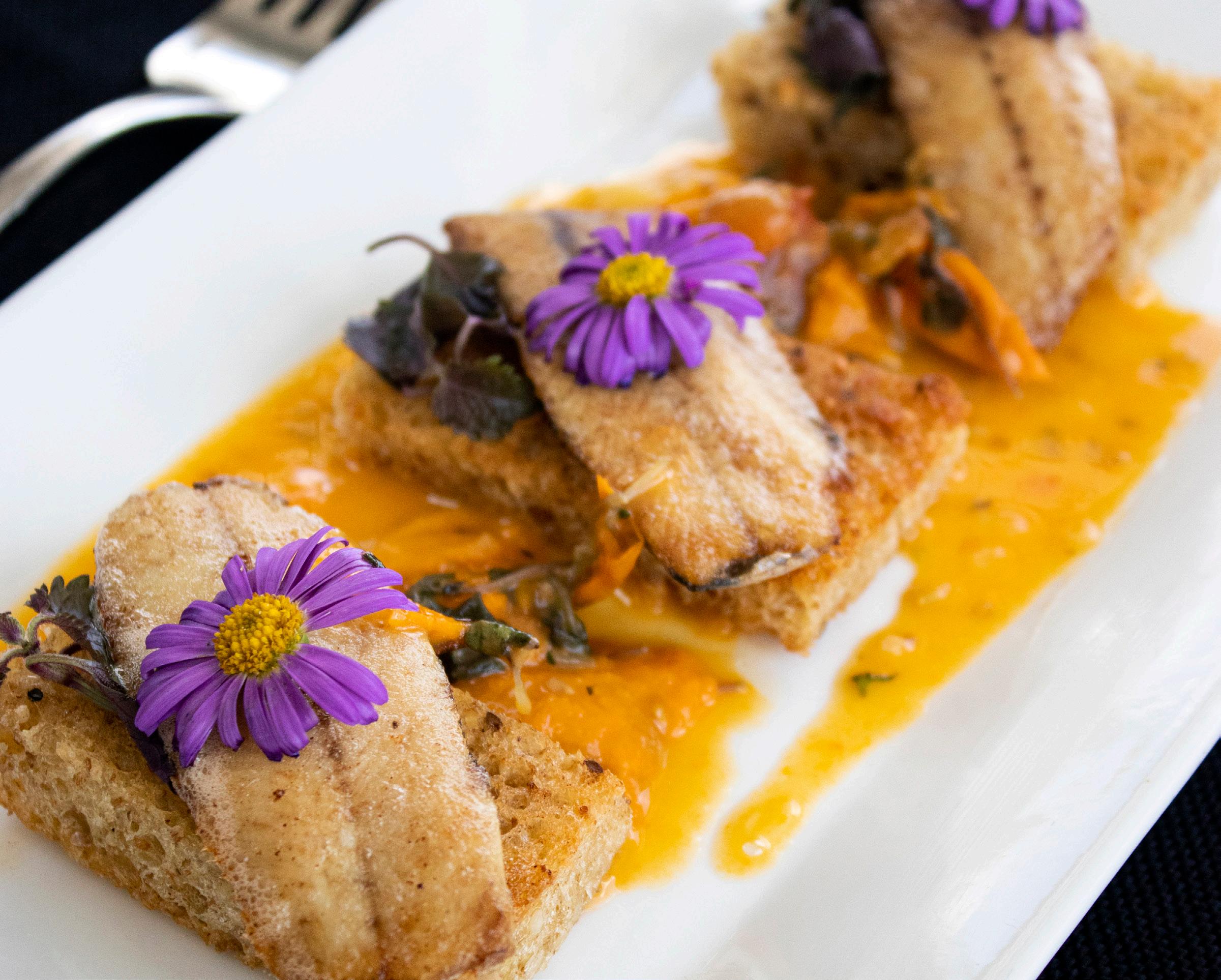
 Whole Broiled Portuguese Sardines with Grilled Sour Grain, Heirloom Tomato Compote, Garlic Crisps, Olive Oil, and Flake Salt
The 2nd hole, image courtesy Brae Burn Country Club
Whole Broiled Portuguese Sardines with Grilled Sour Grain, Heirloom Tomato Compote, Garlic Crisps, Olive Oil, and Flake Salt
The 2nd hole, image courtesy Brae Burn Country Club
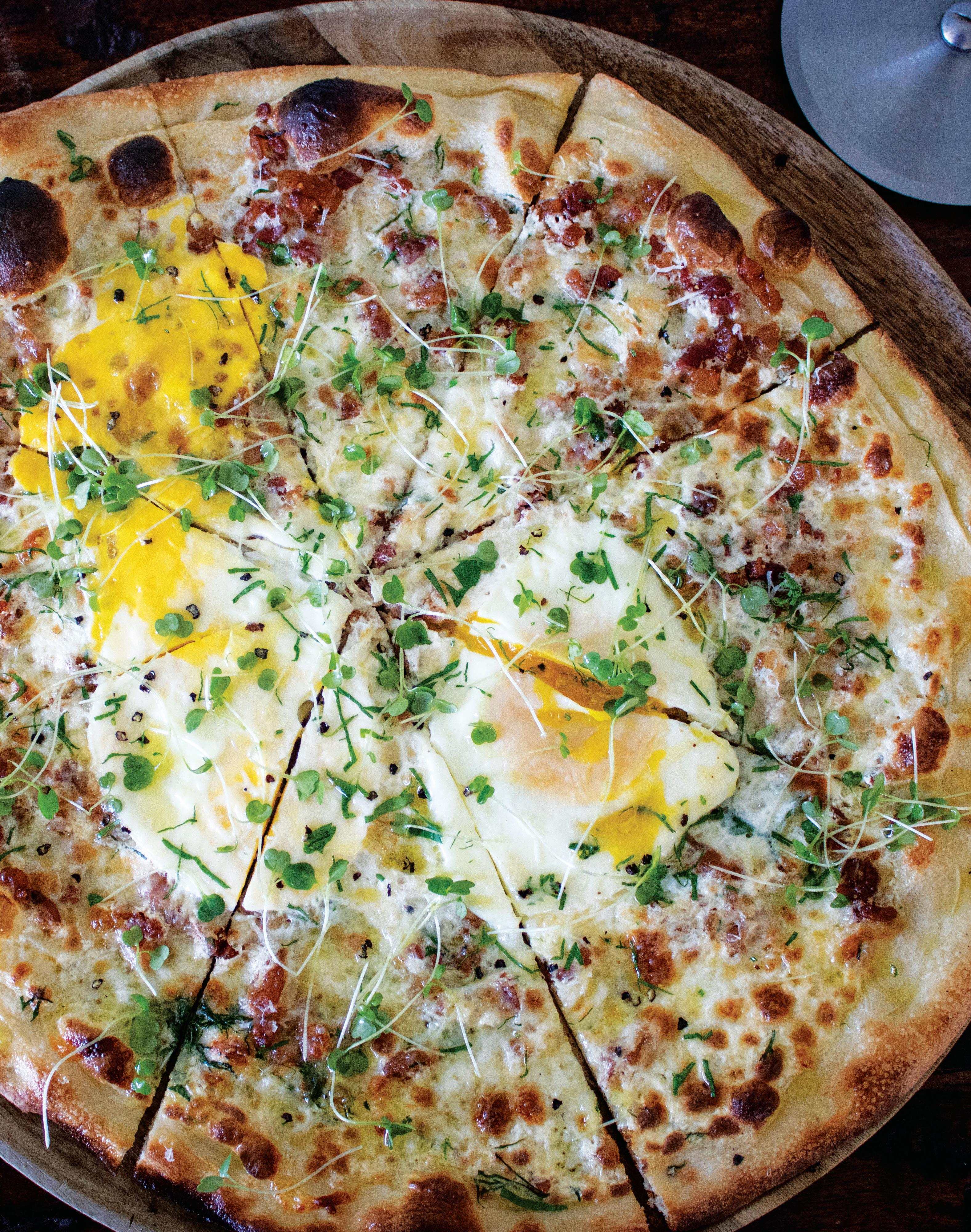
Yield is 4 – 7 ounce balls or 4 - 14-inch pizzas
Ingredients
Pizza Dough
• 1 1/2 tablespoons dry activated yeast
• 1 teaspoon sugar
• 1 1/3 cups tepid water (80 to 85°F)
• 2 1/8 cups Caputo’s pizza flour di Napoli
• 1 tablespoon extra virgin olive oil
• 3/4 tablespoon kosher Salt
Pizza
• 1 cup ricotta cheese
• 1/2 cup whole milk
• 1/2 cup Parmigiano - Reggiano cheese (micro plane, plus keep some for garnish)

• 1 pound of pancetta (small, diced, and rendered crisp. Reserve the fat)
• 1 tablespoon cracked black pepper
• 1 1/2 -2 cups fresh buffalo mozzarella (hand-pulled to create strips)
Chef Note: processed mozzarella works if desired
• 2 whole eggs
• 4 ounces extra virgin olive oil
• 1/2 bunch flat leaf parsley (chiffonade)
• micro arugula (optional for garnish)
Pizza Dough
Measure out all the ingredients. Combine the yeast, sugar, and water in a mixer bowl allowing the yeast to bloom for 10 minutes. Mix the yeast and water with a whisk until dissolved. Add the flour and allow to autolyse (let yeast feed in the bowl until it bubbles) for 25 to 30 minutes. Add the kosher salt. Mix the dough with the dough hook attachment for about 10 to 15 minutes on 2nd speed until the dough clears the bowl. Bench the dough for up to two hours covered. Next, scale the dough to seven ounces, roll it tightly, and lightly coat it with oil; place it in a tight-covered container and refrigerate for 24 hours before using. Let pizza dough sit at room temperature for five to 10 minutes before rolling and stretching.
Pizza
In a food processor, add the ricotta and purée until smooth. Next, add the milk to thin it out, and then add the Parmigiano cheese and purée until smooth. Chef Notes: You might have to adjust the milk to create a consistency that will coat the back of a spoon. Next, stretch the dough to your desired thickness and shape. I stretch the rounds until they are extremely thin and approximately 14 to 16 inches in diameter. Place the dough on a floured pizza peel. I use Caputo’s pizza flour. Spread a thin layer of the ricotta cheese mixture over the base leaving about a half inch from the edges. Sprinkle with the pancetta, cracked black pepper, and a drizzle of the reserved pancetta fat—layer with the pulled mozzarella and parmesan. Crack and place the raw eggs on top. Bake in a 600°F pizza oven of your choice. (wood fire or regular pizza oven) until golden brown, the cheese is bubbling, and the egg is over medium.
Place pizza on the serving vessel, cut into eight slices, and finish with an olive oil drizzle, fresh parsley, and micro arugula.
Italy will be in the eyes of the golf world when it hosts the 44th Ryder Cup Matches (www.rydercup.com this fall (September 29-October 1) at Marco Simone Golf and Country Club in Guidonia Montecelio near Rome. It is the first time in history that the biennial event will be held in Italy.
If you are lucky enough to be part of the contingent cheering on the teams, consider a side trip to Lake Como, a truly enchanted and magical region in the foothills of the Italian alps.
My desire to visit Italy stems from childhood memories in Brooklyn, NY, where the enticing flavors and aromas of Italian dishes filled the restaurants, salumerie, bakeries, and endless Italian food emporiums with deliciousness. With such large populations of both Italians and Jewish people living beside one another in the borough, one couldn’t escape the best of the best of either group’s superb culinary offerings.
I will never forget my first view of majestic Lake Como and its surrounding sharp, angular mountaintops that literally plunge into the deep waters of this world renown lake. Located both adjacent to the Swiss border and amid the mountain foothills, Lake Como’s shores are dotted with quaint old towns, churches, mansions, stunning villas, and medieval towers. This is the perfect destination for those interested in art, history, architecture nature, relaxation, and delectable food—like me!
Bar Delle Terme, in the Albergo Terminus hotel, is a bistro serving traditional Italian cuisine such as lasagna, classic pasta and risotto dishes and charcuterie. In good weather, dine on the lovely terrace overlooking the lake. The flora of delicate jasmine and oleander adds to the beauty of the experience.
When meandering through narrow streets, stop in the small shops and cafes while admiring the beautiful architecture, check out Villa Erba, Villa d’Este, and Villa Bernasconi.
Dining at Ristorante Raimondi in the Villa Flori with panoramic views of the lake is a must see during your stay. A sampling of the excellent dinner menu included “Delights of the Lake,” (creamed pike perch, marinated char, pan seared eel with thyme, smoked lavarello, mis-
soltino fish and polenta), followed by ravioli stuffed with burrata and served with prawns and marjoram sauce. This dish was delicate and beautifully presented. The traditional Como dessert was the sweet ending to this spectacular culinary experience. Called Miascia, it is a fruit cake with a boiled wine sauce served with house made ice cream. It was not your typical holiday fruit cake. The wine choice was from the Lombardy region of Italy, Lugana Ca dei Frati was refreshing with citrus and apple finishes. The extensive wine list covers most regions of Italy.
The kitchen of Ristorante Sottovoce at Vista Palazzo is under the watchful eye of Chef Stefano Mattara, who has worked with several Michelin-starred chefs. When asked about his culinary vision he said, “I present my distinctive gastronomic philosophy through dishes characterized by an intersection of tradition and experimentation, bringing to life a gourmet cuisine with an international touch.” He sources ingredients from the finest local purveyors of authentic Italian specialties then artfully combines them to create an impeccable harmony of flavors, colors and textures.
The rooftop restaurant’s spectacular views, luxurious ambiance along with Chef Mattara’s exceptional cuisine made for an unforgettable culinary experience. Guests may choose from the five-course tasting menu featuring chef’s signature dishes that travel his culinary path or items from the à la carte menu.
A special innovation the chef calls “Orto Dolce” (sweet garden) is a dessert made with fresh vegetables from the garden. As an after-dinner treat, also consider Gin Tonic al Piatto (gin jelly, white chocolate and lime, light cream, fizzy rock, lemon sorbet and tonic water). The dessert is completed tableside, with the server pouring the tonic onto the mountain of dessert. The resulting fizzy presentation is a performance on its own.
One of my personal excursions included a visit to a bakery in the town of Piuro. Here, in a simple stone building, Gianna and Luigi Pasini prepare only two items: biscuits and Torta Fiotetto, a rustic cake made with anisette, apricot, fennel, butter and sugar. I had lunch at La Terrazza, located on a mountain overlooking the town of Chiavenna, where I dined on tagliatelle with wild boar Bolognese. It was here that I learned that in Italy, they will know you are a tourist if you order a cappuccino after 11 am. How? Because the milk, it is believed by the Italians, hinders digestion of lunch and dinner.
Stephen Fries, is Professor Emeritus, and former coordinator of the Hospitality Management Programs at Gateway Community College, in New Haven, CT. He has been a food and culinary travel columnist for the past 15 years and is co-founder and host of “Worth Tasting,” a culinary walking tour of downtown New Haven, CT. He is a board member of the International Association of Culinary Professionals.
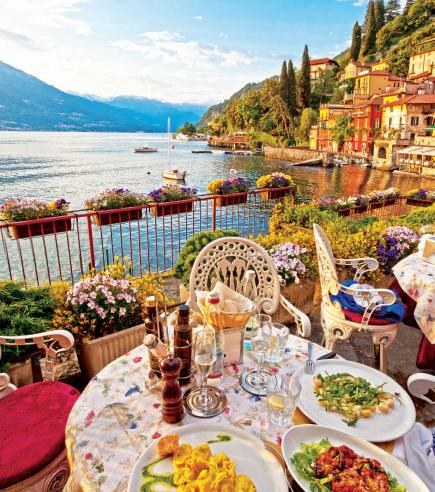
Note: All menus change seasonally at these restaurants to take advantage of available ingredients.

If Lake Como is on your bucket list of places to visit, a stay at a Lario Hotel will make you feel welcome to this magical area that has lured artists, poets, actors, musicians, and writers. It is waiting for you to explore!
My lodging was in three, family-operated Lario Hotels (www.lariohotels.com), each with their own refined, European elegance within a few miles of one another.
Albergo Terminus, with its Art Nouveau-style, located in the center of Como, and across the street from the promenade along the lake, it is convenient to the heart of this ancient city. Built in 1902, the impeccably restored stately building is convenient to boutiques featuring renown Italian brands, and of course restaurants, cafes, and artisan food makers. History buffs will appreciate the nearby cathedral and prominent historic sites. The hotel structure itself is steeped in history, built for the celebration of the hundredth anniversary of Alessandro Volta’s invention, the first electric battery.
Hotel Villa Flori is located a couple of miles from the center of Como. Its panoramic position on the lake is breathtaking. The hotel has a storied history, built as a wedding gift for Marchese Raimondi’s (a renowned Como patriot) daughter. The hotel’s romantic atmosphere of times past, with top-of-the-line amenities in a spectacular setting with breathtaking views from every room’s balcony, you won’t want to leave. The hotel is within walking distance of the town of Cernobbio, where its elegant past is still present.
Next stop was Vista Palazzo, Lario Hotels 5-star hotel and the only 5-star luxury hotel in the city center. Built in 1870, it was originally the headquarters for Schmidt & Lorenzen Silkworks. The impeccable restoration of its Neo-Gothic façade and interior spaces was completed a few years ago to rave reviews. These 18 splendid suites and palatial rooms set new standards in luxury accommodations and pleasure. Residentially styled accommodations convey the joy of feeling at home in one of the world’s most beautiful places.
Although I didn’t stay at Lario Hotel’s Posta Design Hotel, I did take a tour of the hip and contemporary 14-room hotel and enjoyed lunch at its Posta Bistrot. Located on Piazza Volta in the historic center of Como, nearby the lake, it is the perfect place to people watch. The gracious hospitality and quality are the same as their more formal grand properties.
The staff of Lario Hotels makes a special effort to assist guests with unique, exclusive, and personalized outings. On one tour, your private butler will take you to small villages on the lakefront, pointing out ancient castles
and Bellagio, where you’ll walk through the narrow streets studded with boutiques. The history and wine excursion will take you to Bregaglia Valley with its alpine landscapes, close to the Swiss border. If Verona is your destination, then check out Vista Palazzo Verona. The hotel, built in a 19th century mansion is steps away from Juliet’s balcony. Verona was the setting where Romeo and Juliet’s immortal love story took place.
“Cheese In the Alps,” an outing to Bitto’s Valley, known for the production of artisan cheese. And yes, cheese tasting is part of this experience.
Fashionistas might enjoy the “Fashion and Design” tour. Ride in a luxury automobile to Milan, about 60 miles from Lake Como, where you can shop the boutiques in this fashion mecca. In between shopping, there is always time for a coffee break and appetizers.
The Club at Castiglion del Bosco, Tuscany: Europe’s finest golf and wine experience at Italy’s only private members’ club, image by Steve CarrAtop the nearby mountains is Hermau Winery, with vintage produced from grapes grown on mountain ledges. I was given a tour of the winery followed by wine and cheese tasting, while viewing the quaint towns of Valchiavenna and Val Bregaglia from the best vantage points. Visitors can spend the night at Ca ‘Pianazola farmhouse, the winery’s adjacent bed & breakfast with its four guest rooms.
Challenging, scenic and historic golf courses are present in some of the most picturesque and historic locations in the world. For those who travel the world to watch golf events, consider playing a round at one of these excellent layouts, personally recommended by golf travel expert Bill Hogan of Premier Golf.

Castiglion del Bosco:
This course is owned by the Ferragamo family and is part of the Rosewood Resort. Grade A course, but when you add in the resort. Grade A+
Biella le Betulle:
Great course between Torino and Milan. Grade A
Castelconturbia: near Milan - similar to a nice USA country club. Grade A
Verdura Golf: Sicily - Gorgeous waterfront resort. Grade A
Villa d’Este Golf course
Cernobbio (Lake Como) Great course…reminds me of The Olympic Club Lake Course. Highly recommended. Grade A
“ Wine inspires and stimulates the social nerve in our brains, making us connect with the parts sometimes forgotten deep in our soul. In good moderation, it changes the least confident person into a first-class motivational speaker. Many brilliant ideas are sparked during Bacchus’s enchantment, while the God of wine elevates us to the realm of the senses, we become more empathetic with others emotionally and intellectually in ways beyond our imagination”.
Enjoy responsibly!
Fernando Silva Wine Critic, Sommelier, and Artist @bacchusbysilva
95-100 Quintessential Wine: Refined, elegant, and unique, a true expression of varietal, terroir, and winemaking skills, with great aging potential

90-94 Formidable Wine: A wine full of life ready to become a true icon
85-89 Brilliant Wine: Usually fresh, vibrant, and on its way to growth
80-84 Great Effort: Enjoyable at many levels, easy to enjoy, a party-going wine
75-79 Good effort: Wines that are still developing character
50-74 Needs Improvement: Wines that require some fine work
Gaja, Ca ’Marcanda, Vistamare, Tuscany, Italy 2021
Vistamare is a truly amazing and one-of-a-kind wine, a blend of Vermentino and Viognier, with a small percentage of Fiano, all of these vinified separately: Vermentino in Stainless steel tanks, and Viognier in Oak until the assemblage. Gaja delivers hints of white flowers and stone fruit. Fine herbs like rosemary are present as a delicate spice note, laced with ripe tropical fruit towards the finish. Blessed by the Tuscan Sun.
GK 89 Points
Domaine du Roc des Boutires, Pouilly Fuisse, Burgundy, France 2020
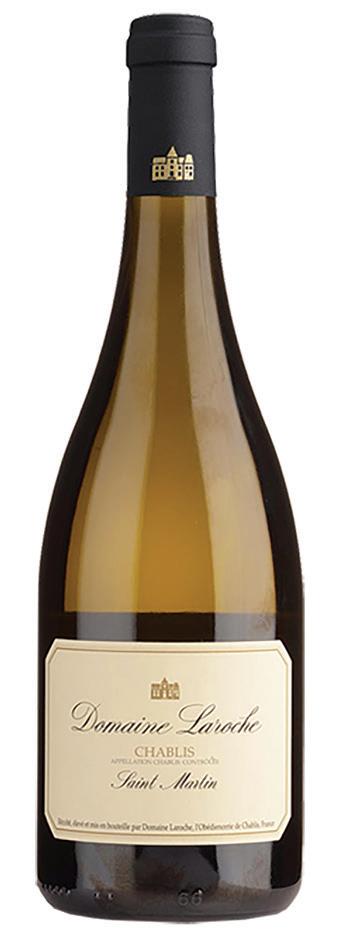

A generous, and rich wine, we find notes of peach, apricot, tangerine, bright acidity, and fleshy structure. Expect a creamy finish that is full of flavor.
GK 87 Points
Schramsberg, Mirabelle Brut, Methode Traditionnelle, NV CA
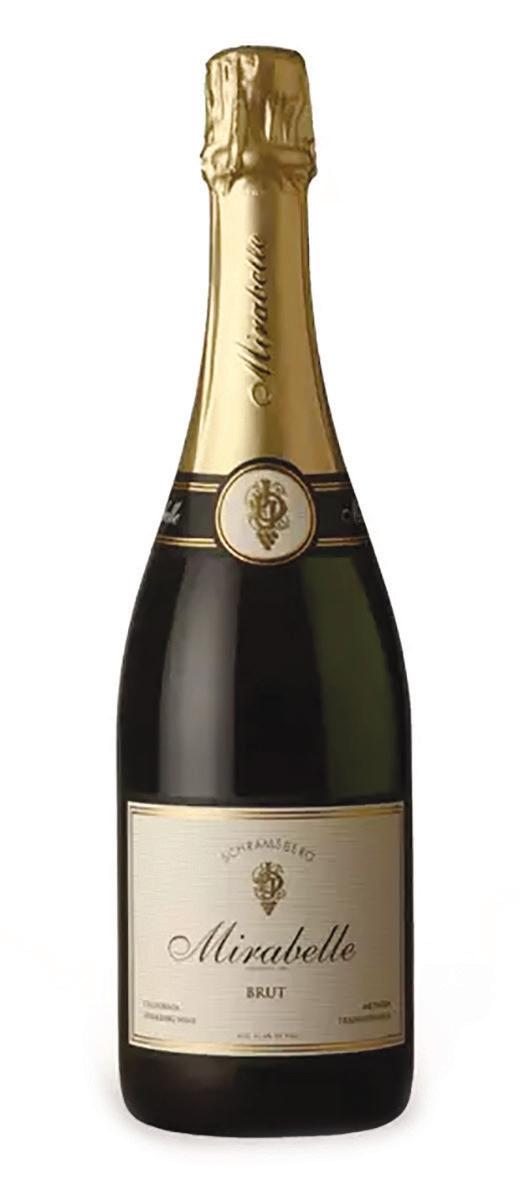
Mirabelle opens with an ample variety of ripe fruit—apricots, apples, and yellow pears. There are also some ginger spice undertones. In the finish, a hint of cinnamon and vanilla, followed by a creamy cookie. Lovely from the beginning to the end.
GK 90 Points
Domaine Laroche, Saint Martin, Chablis, Burgundy, France, 2021
Saint Martin starts off with aromas of white flowers and white fruit, a pronounced minerality and bright acidity, and good complexity of character. It is remarkably enjoyable.

GK 86 Points
Chateau Montelena Estate, Zinfandel, Napa Valley, California 2018

A wine full of power and structure, it opens with aromas of red and dark berries, with notes of cassis, dark bitter chocolate, and light baking spices. Full-bodied and stunningly firm tannins. It can be cellared for up to 10 more years, outstanding value.
GK 91 Points
Comtesse Marion, Cinsault Rosé, Pays D’Oc 2021

This rosé is made of just one varietal, Cinsault, which is traditionally a blending partner. In this case, the wine opens with fresh red fruits—raspberry and strawberry— and a hint of spice and white pepper. Light-bodied and full of flavor.
GK 92 Points
Henry Gouges, “Les Chaignots”, Nuits St. Georges 1er Cru, Burgundy, France 2018
A wine full of power and structure, it opens with aromas of red and dark berries, with notes of cassis, dark bitter chocolate, and light baking spices. Full-bodied and stunningly firm tannins. It can be cellared for up to 10 more years, outstanding value.
GK 92 Points
Gaja, Dagromis, Barolo, Piedmont, Italy 2018
Barolo by Angelo Gaja, the Iconic winemaker that led Barbaresco to international acclaim, Dagromis shows a fine complexity of dark fruit on the nose, with hints of black cherry and blackberry, blue flowers, and an elegant palate with firm tannins. Full-bodied with notes of chocolate and fine cocoa dust. This is an outstanding wine.
GK 93 Points
Chateau L’Evangile, Pomerol, Bordeaux 2011
Pomerol is one of my favorites! L’Evangile 2011 shows beautiful aromas of dark berry and black plum, very seductive and fine tannins, intense black cherry and blackcurrant hints, well-integrated acidity, round and highly enjoyable.
GK 95 Points
Torres, Celeste, Verdejo, “Sur Líes”, Rueda, Spain, 2020
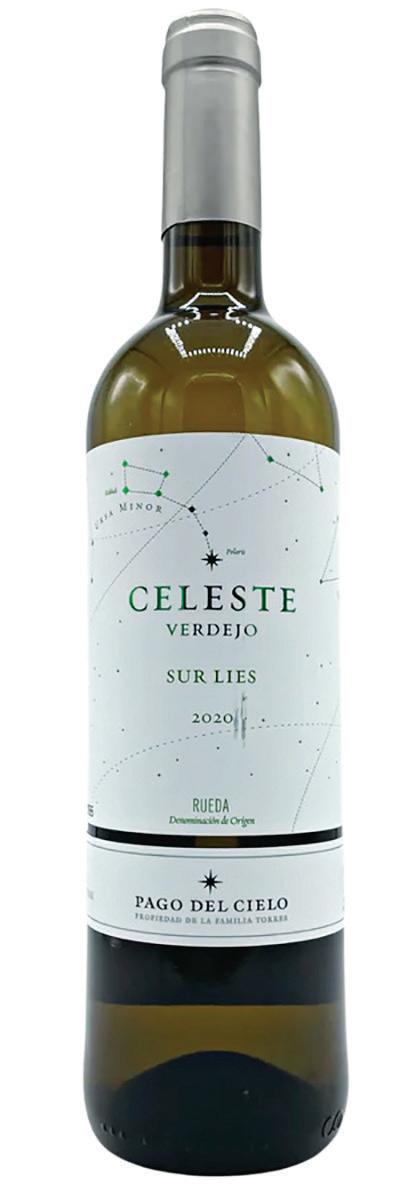
This is a very interesting blend of Sauvignon Blanc and Verdejo. There is plenty of white fruit to savor on the palate and on the nose! White flowers and lemongrass, a hint of white peach, medium-bodied and packed with vibrant acidity.
GK 88 Points
Bergstrom, Cumberland Reserve, Pinot Noir, Willamette Valley, Oregon 2020


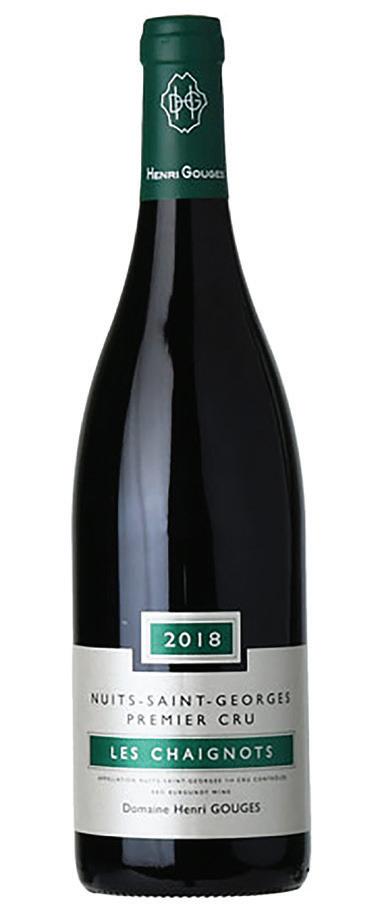
Oregon keeps delivering vintage after vintage of fantastic Pinot Noirs. This Cumberland Reserve is full of elegant red and black cherries, filled with bright and vibrant acidity. This wine is a must for your list.

GK 90 Points
Strozzi, Vernaccia di San Gimignano, Italy 2016
The Vernaccia is a must! As a wine lover, I really enjoy this citrusy charmer, because it has a lot of flavors and is fun, traditional, and conservative, at the same time.
This grape has been around Tuscany for a long time, and of course, it is worth the try. Consider it as aperitivo. A possible show stealer.
GK 89 Points

See.
Sight is key at the beginning of the wine tasting. Looking and observing the wine in the glass, especially against a white background, noting its color and various hues, might give an indication of age, concentration, and to the more trained wine lover, a hint of the varietal.
Swirl.
Oh yes, swirling! I suggest you practice a bit before swirling your glass in the air at a tasting or event. Swirling should be like a dance—almost a delicate movement, intended to oxygenate the wine. This process also liberates aroma compounds and esters that might be dormant in the wine.
Smell.
Sommeliers and connoisseurs call this step “on the nose.” It usually takes two or three times, combined with the swirling of the glass, to identify the primary aromas of the wine, which fruits your senses are beginning to decode and recognize. Later this will be followed by the secondary and tertiary aromas, and in older vintage wines, the famous “bouquet.”
Sip.
When you are serious about the wines you are tasting, it is better to keep a small amount of wine in your mouth and let a small portion of air go through it. Of course, professional wine tasters are well known for their strange, noisy almost guttural rituals.…but until you get more serious about wine tasting, I recommend you sip and evaluate at your own pace.
It is during this sipping step that we will reconfirm the observations had at the beginning--the colors, the initial swirling, and the smell or nose.
Savor.
Now we are ready to completely evaluate the qualities of the wine. We can enjoy the glass and connect the dots of the five steps. Remember, the best wines are like a good movie or a good book. They always take you through a journey of the senses.
Enjoy responsibly.
Walking into a wine tasting setting shouldn’t be intimidating. Savor it as a multisensory experience, a journey through the senses. Here are five easy steps to enjoy tasting like a true connoisseur… and to look good in the process.
— Fernando Silva, Artist & Sommelier
Golf raises more money for charities and foundations than any other sport in the United States, so I was not surprised that the Berenberg Invitational, held at GlenArbor Golf Club in Bedford Hills, New York, raised $1.4 million for the Nebraska Pancreatic Cancer Center of Excellence during two events.
Sunil Hingorani, MD, Ph.D., is the inaugural Nancy Armitage Presidential Chair in Pancreatic Cancer and Professor of Internal Medicine in the Division of Oncology and Hematology at the University of Nebraska Medical Center and serves as the Director of the Pancreatic Cancer Center of Excellence. Dr. Hingorani’s research helped develop the first mouse models to accurately mimic human pancreas cancer from its precancerous inception to its advanced
stages. He has used these models to identify genetic events, signaling pathways, and collaborating cell types that contribute to the aggressiveness of ductal adenocarcinoma, the most common and deadly form of pancreas cancer.
Dr. Hingorani has made multiple breakthroughs in his lab that have informed the course of his latest phase of research, as well as that of others. His lab is testing these ideas in a novel Murine Clinical Trials Program to identify strategies most likely to succeed in patients.
I was privileged to spend some time with Dr. Hingorani during the Berenberg Invitational to learn about his vision and how the event has been designed to raise money and much-needed awareness. ~ Diana DeLucia.
 The GlenArbor clubhouse looks over the 18th green.
The GlenArbor clubhouse looks over the 18th green.
GK: Tell us about your background prior to your role at the Nebraska Pancreatic Cancer of Excellence.
SH: I was born, raised, trained, and educated in the Northeast and did most of my clinical and post-doctoral research in Boston. From there, I spent a few years in Philadelphia and then went to Seattle because there was an opportunity to build something new in pancreatic cancer. It was relatively early in my career, and I had many ideas about the most productive way things should be achieved with pancreatic cancer treatment and research.
The Fred Hutchinson Cancer Center has a tremendous reputation for so-called liquid tumors, leukemias, and lymphomas. They invented bone marrow transplantation to treat such cancers. They didn’t have much presence in solid tumor oncology fields, and they made a concerted effort to start establishing that. They gave me the freedom to build a program my way. I spent the next 17 years creating a unique program where we designed everything with the patient as the focal point. Everything was reconfigured for the convenience and ease of the patient experience.
GK: How did Nebraska come about?
SH: I wasn’t looking to leave Seattle, but what happened in Nebraska was a rare confluence of circumstances. Nebraska State Senator, Mark Kolterman, who lost his wife to pancreatic cancer, and a core group of philanthropists and benefactors in the Omaha area came together and hatched a plan to convince the state. “We will put up a specific amount of resources if the state can match it.” The University, The Nebraska Foundation, Nebraska Medicine, and these philanthropists found a way to raise funds rapidly. The resources became available, and a new
cancer center building was built. The Fred and Pamela Buffet Cancer Center is now four years old and is tied to the University of Nebraska Medical Center. This gleaming, 10-story building has an entire floor dedicated as the new Pancreatic Cancer Center of Excellence.
GK: How did you bridge the gap between research and patient care?
SH: The irony of what we do and how we’re trained in science and medicine is that the PhDs get trained where the research opportunities exist; clinicians are getting trained in the hospitals and clinics on campus. And even if they’re on the same campus, they might as well be across the world because they get so busy and so absorbed in what they’re doing that they don’t have time to walk or drive across campus during the day. The one thing that always baffled me is, ‘why don’t we put those two groups together?’ The NIH (National Institutes of Health) tried to solve this problem about 50-60 years ago by creating a program to train people to do both. They created the concept of the MD / Ph.D., the physician-scientist, and paid tuition for qualified students. I’m one of those physicianscientists. I needed to have these two worlds co-localized. I bring them together once a week or once a month for conferences and encourage them to think differently about certain questions during such meetings, but I wanted them to bump into each other spontaneously and more frequently. You need those serendipitous conversations to occur all the time in the hallways and stairwells, as that is often when the most important research ideas might pop up. Among the benefits of joining outpatient clinics and research laboratories is to focus the work in ways that will more rapidly and effectively improve a patient’s diagnosis and treatment.
“Through my relationship with BERENBERG I have met many of the doctors dedicated to the University of Nebraska Medical Center and its leading Pancreatic Center of Excellence.
I follow their work and am proud of BERENBERG and GlenArbor Golf Club for raising the critical funds to allow further learning.”
— Tom Watson
GK: Have you made this a reality in Nebraska?
SH: We created a real-time multidisciplinary clinic, the Pancreatic Diseases Specialty Clinic (PDSC) with the Center of Excellence. In the PDSC, patients arrive and receive “one-stop shopping” where they receive a comprehensive care plan that incorporates all of the disciplines and support services into their care. During the patient conference portion of the visit, there are 30-plus people in a room spanning surgery, medical oncology, radiation oncology, gastroenterology, nursing, genetics, nutrition, symptom management and supportive care, social work, spiritual services and so on. Together, the radiology imaging specialist performs the CT scans and projects them onto a large screen. The pathologist reads the biopsy and describes the type of cancer. Everyone, including support staff, residents, and fellows, then participate in a robust discussion to develop the best care plan tailored to each patient. In a subsequent patient meeting, the plan is delivered and all necessary appointments for the next several months are scheduled.
GK: How did you get involved in the Berenberg Invitational at GlenArbor Golf Club?
SH: I was introduced to Grant Gregory, the owner of the club and a great supporter of the university, partly because of his deep friendships with Gary Player and Tom Watson. We met on the campus in Omaha at the University of Nebraska. Grant sat down and started laying out a plan for what the event could look like and how to market it to raise awareness, make an impact against this disease, and start pushing toward finding a cure. We need champions to help generate awareness and fund campaigns in the way that breast cancer, for example, has done so successfully. These champions are typically the survivors that had significant successes. Pancreas cancer, however, is almost always fatal. Its course can be short and painful. The patients and their families may not even have time to fully absorb and understand what’s happening. This situation frequently leaves the family devastated and emotionally drained. It feels unethical to ask them to step outside themselves during this time to try to raise money or awareness.
The Berenberg Invitational held its first event to benefit pancreatic cancer research in October 2021. It included a star-studded lineup of well-known golfers, many of whom had lost partners or family members to the disease including Gary Player, Tom Watson, Fred Couples, Mark O’Meara, and a host of major championship winners from the men’s and women’s professional tours.
The attention these players and the golf industry command is exceptional in raising awareness and continuing our mission to find the cure in the next five to 10 years. In 2021, the event raised around $750 000 in one night. In 2022, we exceeded this total.
“With my beloved wife passing away from pancreatic cancer, the Berenberg Invitational and its beneficiary hold a special place in my heart. Fighting this terrible disease is an endeavor we must take on together. Events like this one certainly give all the doctors, scientists and researchers an added edge to combat and find a cure so many desperately need.”
Gary Player


 Golfers and caddies take a break at the halfway house at GlenArbor Golf Club, images courtesy: C&R Public Relations
Left to right: Gary Player and Kyle Roig Tom Watson
Golfers and caddies take a break at the halfway house at GlenArbor Golf Club, images courtesy: C&R Public Relations
Left to right: Gary Player and Kyle Roig Tom Watson
There’s something about small bites that are just so visually appealing, especially when plated with simplicity and elegance. I photographed this Pan Seared Port Lincoln Scallops recipe by Nigel Munzberg, Executive Chef at Royal Adelaide Golf Club, Seaton, South Australia, in 2015, and it’s stunning. It still looks as mouthwatering today as it did then. It’s incredible how a well-plated dish stands the test of time.
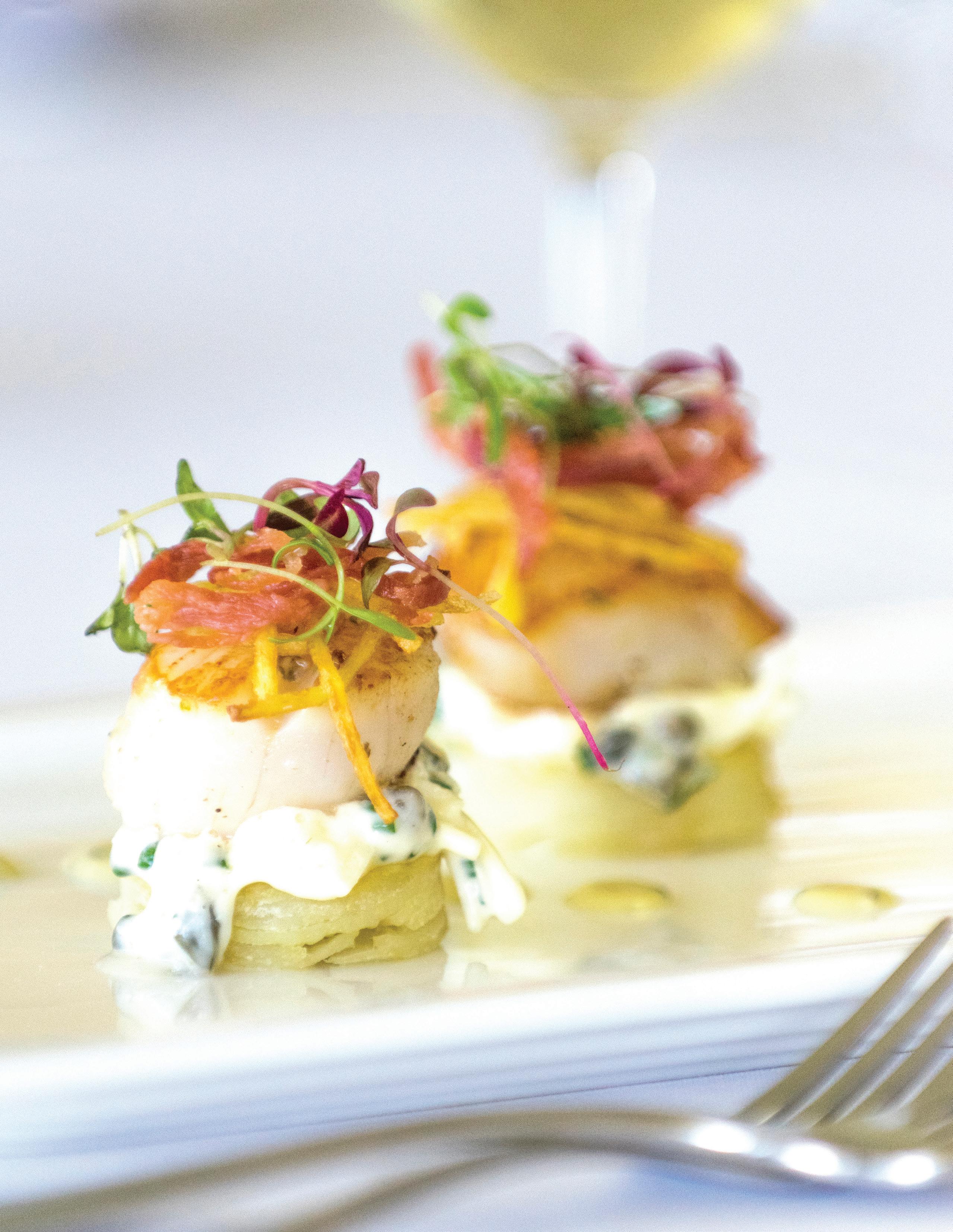
Capturing moments in time through photographs has been a tradition passed down from generation to generation. Before that, stories were conveyed via artists’ paintings and drawings, including many of food.
Why does a club need professional legacy-quality food and beverage images?
Preserving the Club’s Culinary History
Photography is an integral element of preserving a club’s culinary history. With the current generation of members often joining as social members, the club culinary scene is becoming even more relevant. Legacy, quality images chronicle a private club’s pride in its food and beverage, which has the potential of placing the club front and center ahead of its competition and in front of potential younger members seeking clubs to join.
Many private clubs spend a fortune on the golf course and clubhouse photography and leave the food as an afterthought. Private clubs have come a long way in the last 15 years, and thanks to publications like Golf Kitchen and Club and Resort, strides have been made to give many opportunities to highlight the culinary talents in the club industry on a high level.
A club should pay attention to and devote resources to its culinary marketing. Many chefs spend hours and days perfecting a recipe, its plating and design and then take a quick iPhone snap, completely ruining the image they wish to convey. Worse still, they post photos on social media for the world to see. Nothing is worse for a club or a chef than having unprofessional food images in member newsletters or to fulfill media requests. This certainly does not convey professionalism.
In this age of storytelling, recipes and photographs have unique stories. My experience in the restaurant world and interacting with legends of cuisine, has taught me that preserving these stories and images creates a visual record and leaves a legacy for future generations of members. But remember, be prepared for your photoshoots as it all starts with what is on the plate.
A professionally produced resume and a portfolio of images can make you stand out, separate you from the crowd, and secure a new position. You are competing with many other club chefs, and with the industry becoming more renowned, you are likely competing with seasoned restaurant chefs who possess extensive professional photography portfolios. Invest in yourself.
Soups are always satisfying and comforting, no matter what the occasion. Showcasing your best soups in photographs is a great way to entice members to return for more. A well-composed photo of a bowl of soup can make mouths water— this photograph of a New England Clam Chowder recipe by Michael Ruggiero, GlenArbor Golf Club, New York, is a fine example.
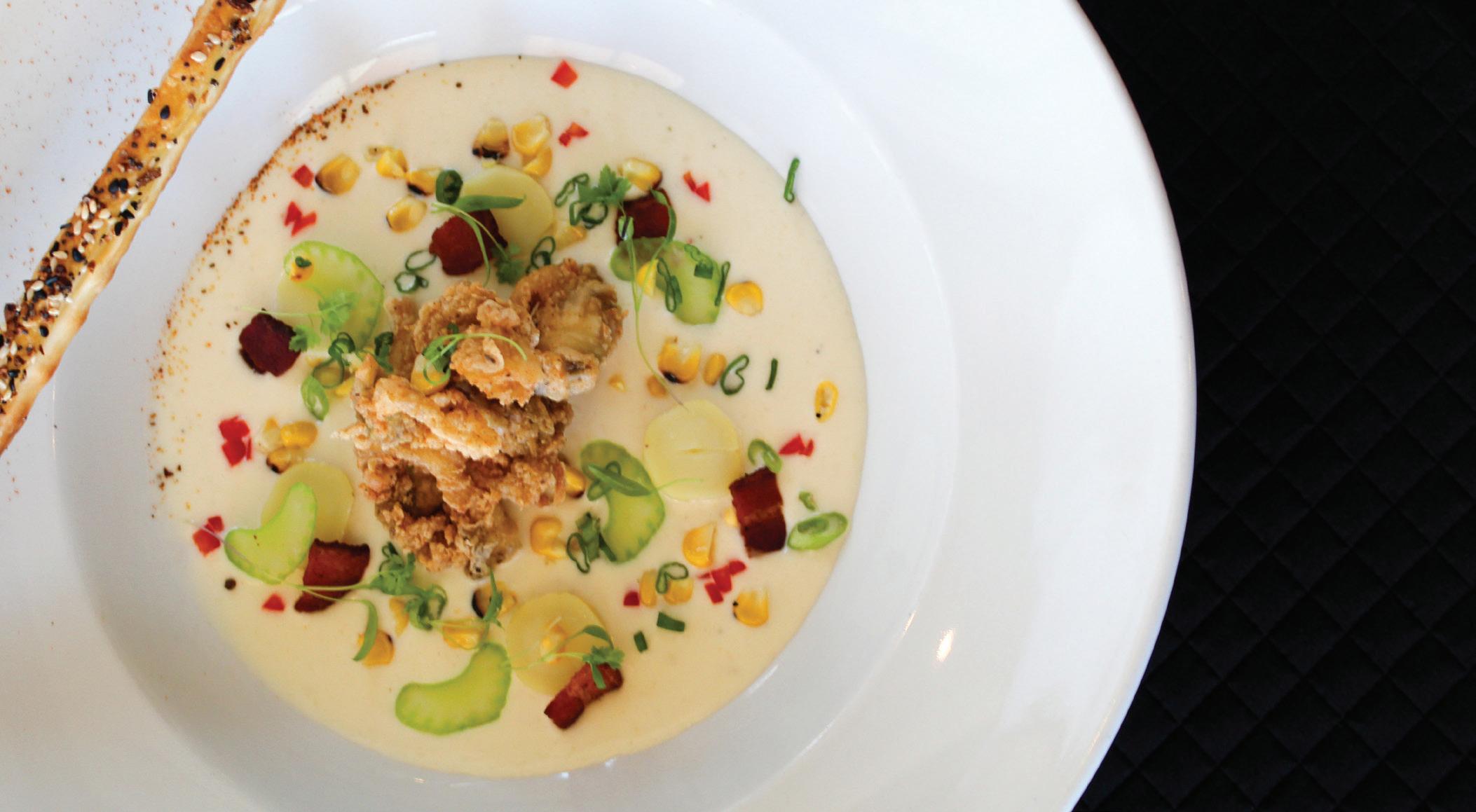
Don’t forget the Salads!
Salads may not always be the most exciting dish on the menu, but when crafted by a skilled chef, they can be a true work of art. If your club has access to a talented culinary team, don’t hesitate to showcase their impressive salad creations in your photography. Stunning visuals can truly elevate the perception of a salad. often-overlooked category. This Honey Crisp Butternut Squash recipe by Jonathan Hancock at Richland Country Club, Nashville, Tennesse, has been published internationally.

Perfect Pasta Pasta is a favorite among golfers, members, and guests. Its a filling meal with many different styles that cater to all taste buds. This Pappardelle with Manilla Clams and Porcini was shot at Addison Reserve Country Club, Delray Beach, Florida, and was created in 2017 by former Chef Zach Bell.

Don’t be afraid of Beef!
Even with the rise of plantbased diets, many golfers still crave a good beef dish. However, it seems that capturing the perfect shot of these meaty creations can be quite a challenge. Believe it or not, this Brandt Beef Bone Marrow Bread Pudding recipe by Doug Blair at Cassique at Kiawah Island Club, South Carolina, took four hours to create and shoot!

Asian Fusion
Are your members passionate about Asian cuisine? If so, why not showcase this preference by creating visually stunning photographs of their favorite dishes?
I shot this Tuna Sashimi with Avocado, Citrus, Almond Crunch and Tataki Sauce recipe by Scott Haegele at Royal Poinciana Golf Club, Naples, Florida in 2018.


Dessert Delight
There’s something about the sight of a decadent dessert that can make your mouth water with anticipation. Whether it’s the rich, creamy texture of a chocolate mousse or the flaky, buttery crust of a fruit tart, there’s no denying the power of a beautifully crafted dessert to create lasting memories. I photographed this Huckleberry Pie Gelato at Cassique at Kiawah Island Club, South Carolina. It looks like you can eat it right from the page.

Clubhouse Cocktails
In todays world, its crucial to present your bar’s best cocktails with high-quality photographs. With the current emphasis on creative concoctions at clubs across the country, having impeccable photography can make all the difference in attracting customers and standing out from the competition. This Campfire Old Fashioned was created by Junior Sous Chef Jeremy Bland at The Club at Carlton Woods, The Woodlands, Texas, and is an example of how some clubs are highlighting their bar offerings.

Culinary Staff
When holding a professional photo shoot at your club it’s important to include the entire culinary team—in the organizing and planning process. Editorial quality images may be used in media features, event promotions, newsletters, portfolios, social media posts, websites, and even resumes.


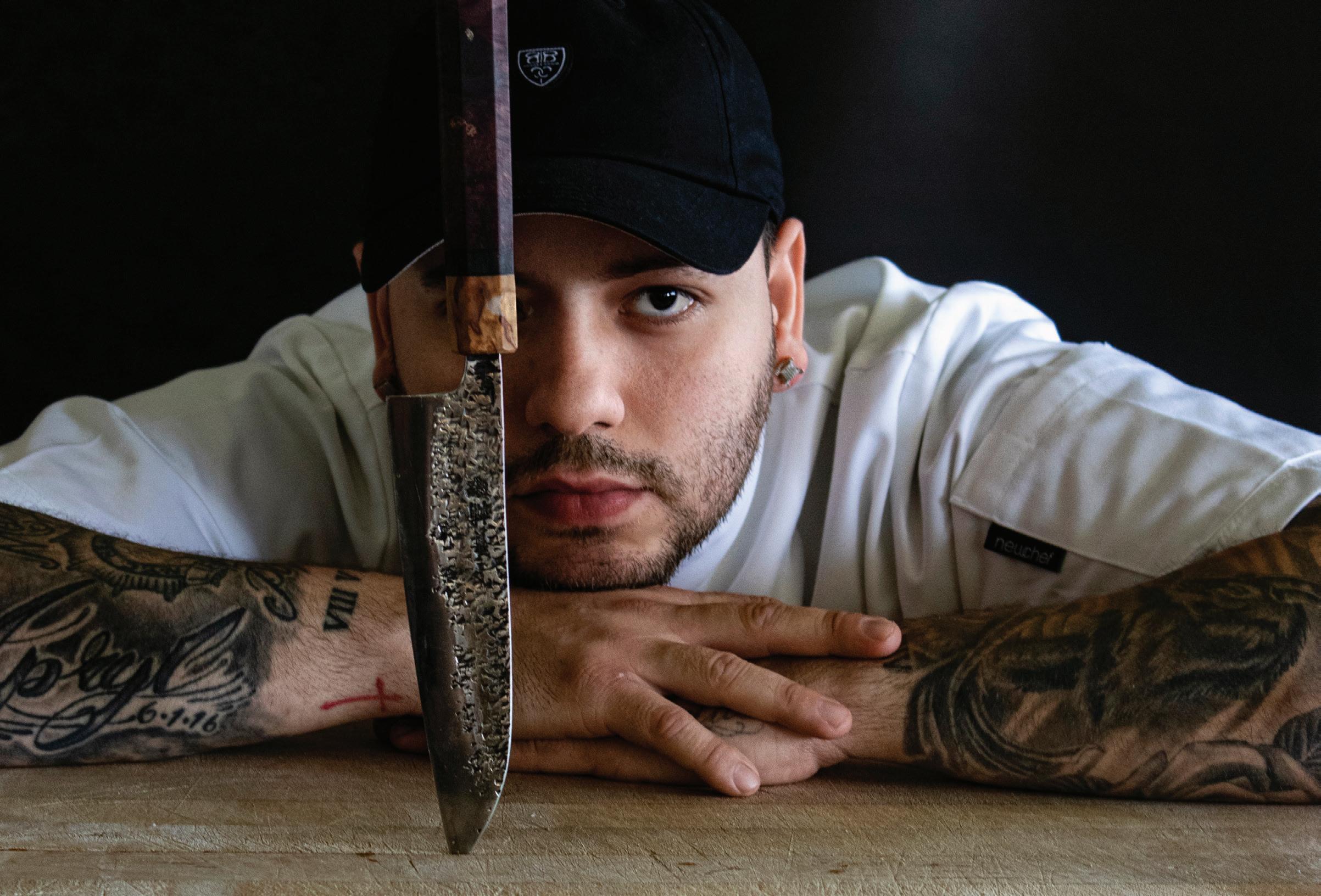 Matt Marrero, Sous Chef, Bonnie Briar Country Club, Larchmont, New York
Chrissie Bennett, Executive Chef at Winged Foot Golf Club, Mamaroneck, New York
Aaron Ruble, Executive Sous Chef at Sycamore Hills Golf Club, Fort Wayne, Indiana
Matt Marrero, Sous Chef, Bonnie Briar Country Club, Larchmont, New York
Chrissie Bennett, Executive Chef at Winged Foot Golf Club, Mamaroneck, New York
Aaron Ruble, Executive Sous Chef at Sycamore Hills Golf Club, Fort Wayne, Indiana
PhilAnthroPy


The club network is powerful…and generous. Which is why, during the Covid pandemic, ClubsHelp led the way to bring support to —and from—clubs and their communities in need.

Since then, the mission and reach of ClubsHelps’ 501(c)(3) organization expanded its reach nationally so the generosity and the collective power of the golf industry can continue to change lives.
Last year, for example, ClubsHelp and the Arnold & Winnie Palmer Foundation stepped to the plate to raise more than $150,000 to support employees of Oakland Hills Country Club impacted by a devastating fire in their historic clubhouse.
Tapping into golf industry networks of golf course owners, club managers, golf course architects, golf professionals, members, media, and corporate partners, a team effort helped pool resources to jump start the rebuilding effort. Recently, ClubsHelp Foundation Inc. joined forces with Eagles For Children (EFC), which coincidentally got its start at Oakland Hills Country Club, in a collaboration aimed at combining resources to create a greater impact.
Founded in 2012, EFC has participating clubs across three states and has raised more than $5 million to support charities advocating for the needs of disadvantaged children with the 2022 golf season alone raising over $1 million for worthy causes.
EFC is a qualified 501c3 organization with a fun, golf-centric fundraising model that allows private country clubs to raise money each golf season through a simple act made by the members of each participating club—pledge $2 for each eagle made by a fellow member. At the end of the season, each club directs 100% of the monies raised to charities of their choosing in their community.


EFC provides the fundraising platform for the operation of the program, offers the infrastructure for the administration of the program, and privately funds the cost of this oversight to ensure that all monies raised by clubs are directed to those charities serving disadvantaged children in the communities served by each club.
Fundamental to the program is the recognition that membership at a private club is a privilege and along with it comes a responsibility to be an impactful participant in the well-being of their hometowns.
While most clubs already engage in the support of amazing charities like Evans Scholars or Scholarship Trusts for their employees and their children, EFC was uniquely conceived to offer a model to have a positive impact outside club gates to champion causes that, in many cases, are already being supported by many of the club members.
It is this outward focus and mission of community impact that aligns perfectly with the ClubsHelp mission of ‘Caring Locally’ and EFC is delighted to partner with ClubsHelp to bring this program to those clubs already participating in the great work being done by ClubsHelp.

The power of the EFC system is the simplicity and the premise that a little bit of sacrifice by a lot of people can yield powerful results.
After 11 years of operation, Don Kegley, EFC co-founder, was asked ‘what is the most frequently asked question you receive about the program?’ Kegley said, “By far, when clubsultimatelyunderstandandjoinusonthisjourney,they simply ask ‘Why don’t all clubs do this?’ The good news is that more and more clubs are doing this and as a result, we are all using the game we love to help kids in communities surrounding our clubs.”
With ClubsHelp and EFC working together, many more clubs will join and there is literally no limit to the funds that can be raised, and the lives changed—$2 at a time.
More information about Eagles for Children can be found at www.eaglesforchildren.org and to get your club involved, access the ClubsHelp website at www.clubshelp.org
“By far, when clubs ultimately understand and join us on this journey, they simply ask ‘Why don’t all clubs do this?’ The good news is that more and more clubs are doing this and as a result, we are all using the game we love to help kids in communities surrounding our clubs.”
— Don Kegley EFC co-founder
There is unprecedented growth of craft distilleries in the U.S., and if you keep an open mind and ready taste buds, you’re in for a beautiful and, perhaps, unexpected journey into the world of whiskey.
According to Forbes Business Insider, the growth of high-quality craft spirits is being driven by consumers with a wider palate and a desire for new innovative flavors. The industry has responded positively with substantial growth and loads of options. The American Craft Spirits Association noted an increase in U.S. distillers from 1,500 in 2017 to 2,290 in 2021. The whiskey family dominates this expansion and is rapidly selling to individuals, private clubs, and high-end dining venues.

What does all this mean for whiskey lovers—whether it’s Bourbon, Rye, White, Tennessee, or the many blends? There are new opportunities to try a broad, high-quality selection of whiskey made by producers from all over the country. These purveyors bring dedication and enthusiasm to the craft and embrace all the best attributes of the old moonshiners.
We all have our to-go-to favorites - Johnny Walker, Buffalo Trace, or others with a rich and long lineage of 200 years or more. We love their histories, flavors, and consistency. But if you open your horizons and palate, you will be amazed by the variety of options at all price points.
It’s important to remember that craft distilleries and the age of their offerings may have a different taste to what you are accustomed to drinking. For example, Johnny Walker Black is aged for 12 years; others for 18 years. This makes a difference in the flavor notes but not necessarily in a negative way. Size also matters. Most young distilleries will have 200 or fewer barrels aging at any time. It’s a significant investment that won’t provide a return for at least 2.5 years for them.
When delving into the unknown, ask those who drink for a living. Bartenders are a great resource for information but understand that preference and taste are very subjective.
If you would like to add to your club offering or restock a personal

FACT: To be called a bourbon, the whiskey must be produced in the USA. It does not need to be made in Kentucky (contrary to popular belief), although 95% of bourbon is produced there.


bar, check out The 100 Best Bourbons of 2023 Ranked on uproxx.com or one of the many bourbon blogs on the internet:
• Bourbonbanter
• Bourbonblog
• Gobourbon


• Bourbonguy
• Fredminnick
• Sourmashmanifesto
• Thewhiskeywash
These are the most popular bourbons on the market.
Bulleit Bourbon - inspired by the whiskey pioneered by Augustus Bulleit over 150 years ago.
Maker’s Mark Bourbon Whiskey -- a small-batch bourbon whiskey produced in Kentucky.
Jim Beam Bourbon Whiskey - founded in 1795 and passed down through one family for the past seven generations, this is the world’s best-selling bourbon.
Basil Hayden’s Kentucky Straight Bourbon Whiskey - carefully matured and distilled in the heart of bourbon country.
Woodford Reserve Kentucky Straight Bourbon Whiskey - built around flavor, the art of making fine bourbon first took place in 1812 on the site of the Woodford Reserve Distillery, a National Historic Landmark.
Knob Creek Kentucky Straight Bourbon Whiskey - meticulously aged in white oak barrels with maximum char for an unmistakable richness and signature sweetness.
Buffalo Trace Bourbon - a history of producing some of the finest and most awarded bourbons in the world made from the finest corn, rye, and malted barley sourced from local farms near the distillery (their WL Weller is incredible).
Evan Williams Bourbon - Founded in 1783 on the banks of the Ohio River, Evan Williams is one of the oldest distilleries in the country.
Wild Turkey 101 – aged in American White Oak barrels the high rye content and 101 proof makes it a most flavorful Kentucky Straights Bourbon Whiskey, with a bite.
Add this to your target list: Milam & Greene Whiskies, Award-winning - Forbes called it the “best whiskey in America,” with a rich heritage in both the Hill Country of
Texas and the heart of Kentucky. From a 300-gallon copper pot still and the classic vertical column stills, each producing different notes and character - it is aged, batched, and blended with vintage from around the country. Straight Rye and Bourbon - true “grain to table.”
How about traveling to try new whiskeys and to develop an appreciation for regional differences and small production runs by local distillers?
If you’re in Wilmington, NC, End of Days (EOD) is an unexpected pleasure, and conveniently located near some great U.S. golf courses. EOD has 160 barrels aging for future consumption with hopes for future expansion. The Survivor’s Cut Series Bourbon (a nod to the Pandemic) was aged in 53-gallon oak barrels using locally grown corn. EOD Bourbon is surprisingly smooth and strikes an interesting blend of flavors - and not too sweet.
Heading west and in the heart of bourbon country is Old Forester Distillery, located on Whiskey Row in downtown Louisville, Kentucky. For 150 years, the legacy of Old Forester has grown.
To see how your travels or your golf line up with distilleries, check out this website: Distillery Trail. You can look up distilleries by state, spirits, or map. There are also details on festivals, tours, experiences, and trails.
Pappy Van Winkle bourbon is renowned for its high price and limited availability. Their offerings are highly regarded for exceptional quality and craftsmanship.
The whiskey is meticulously crafted using traditional methods and made with high-quality ingredients. The Van Winkle family has a long-standing reputation for producing top-notch bourbons, which further adds to their appeal and justifies the higher price. These bourbons are produced in extremely limited quantities, making them highly sought after by collectors and bourbon enthusiasts. This limited supply creates a sense of exclusivity and drives up the price.
If you like the flavor when you drink it and it makes you feel good, it is a good bourbon, and no one has the right to tell you otherwise.
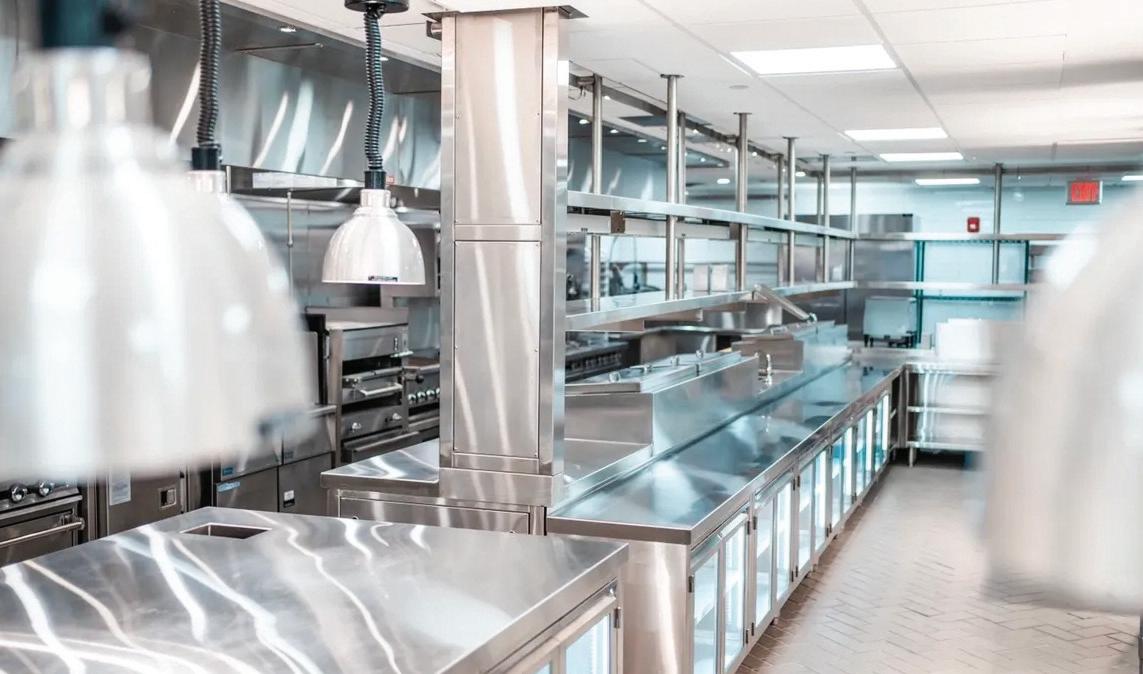
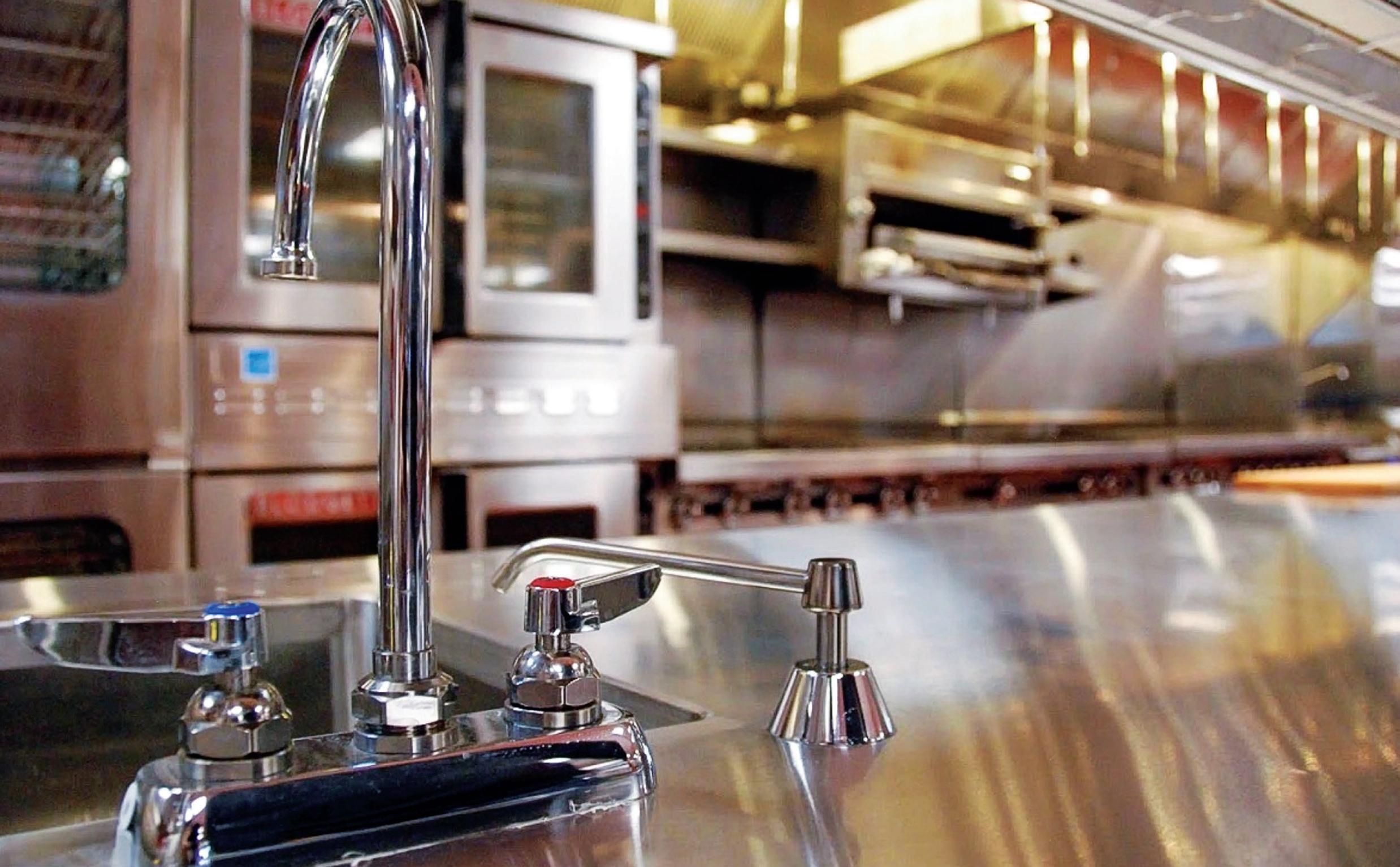


From the spicy and savory snacks of Thailand’s night markets to the hot dogs and pretzels sold on the streets of New York City to Kefta and Merguez sandwiches in the alleys of Marrakech, street food offers a quick and tasty way to grab a bite to eat on the go. As a kid growing up in Morocco, I always grabbed a snack on the way home from school, trying something different each day.
Street food is a popular and beloved aspect of many cultures worldwide. While this phenomenon has been most recently popularized in the U.S. by food trucks and farmer’s markets, cooking on the streets is a fixture in many countries and it’s estimated that 2.5 billion people worldwide consume street food daily. In India, which recently surpassed China as the most populated country in the world, it is estimated that street vendors comprise 2.5 percent of the population. In Latin America, more than 30 percent of the household budget in urban centers is spent on street foods.
One of the advantages of street food is its affordability. Because independent vendors often sell their wares with limited overhead costs, street food can be an excellent option for those on a budget. Additionally, street food can provide a window into a particular region’s local culture and cuisine, allowing visitors to experience tastes and flavors of a place in a unique and authentic way.
Street foods offer a unique and authentic culinary experience that can’t be found in restaurants. Street food vendors often specialize in a particular dish or cuisine, making for a more genuine and flavorful meal. Most of all, street food can offer a sense of community and socialization. Many street food vendors are in busy areas where people gather and can enjoy a meal together, fostering a sense of camaraderie and conviviality.
I am always in pursuit of street food recipes primarily because I enjoy recreating the authentic flavors and dishes I experienced while traveling or living abroad. Street food is a way to connect with local cultures and cuisines, and I want to bring those experiences home with me. In my ongoing quest to experiment with new and unique flavors, street foods are my inspiration. Vendors often use fresh and local ingredients with a wide range of flavors and textures that may not be found in traditional restaurants. ~ Chef Z
GK: Why do you possess a love of street food?
Chef Z: Street food lets me capture a snapshot of local food’s authentic feel and taste. It allows me to connect with people from all over the world who share the same passion.
GK: Why are you in pursuit of global street food recipes?
Chef Z: Each dish or recipe represents that specific cook or chef’s journey. These recipes are typically part of a tradition passed down through generations.
GK: Which countries have you visited in search of street food?
Chef Z: France, Spain, England, Netherlands, Switzerland, Mexico, Jamaica, India, and Italy.
GK: What are your bucket list countries and why?
Chef Z: Israel, Thailand, and Indonesia. I want to try the rich food culture that these countries have in abundance.
GK: Tell us about the street food concept at the Richland Pointe restaurant?
Chef Z: I have always been fascinated with learning about different cultures. There is no better way than immersing myself in the local food scene, and as a chef, I always want to introduce my guests to the different flavors I have experienced through my travels. Richland Pointe is a perfect canvas. For example, we introduced Mexican street corn (Elote), larb, yakitori. The butter chicken has turned out to be a widely popular menu item.
“ I am always in pursuit of street food recipes primarily because I enjoy recreating the authentic flavors and dishes I experienced while traveling or living abroad. Street food is a way to connect with local cultures and cuisines, and I want to bring those experiences home with me.”
— Chef Z


Bhel Puri is the snack you eat after a day at the beach. My first taste was at nighttime when everyone was having fun and families were gathered around multiple small plates of food chatting about their day. It made a happy impression on me. ~ Chef Z
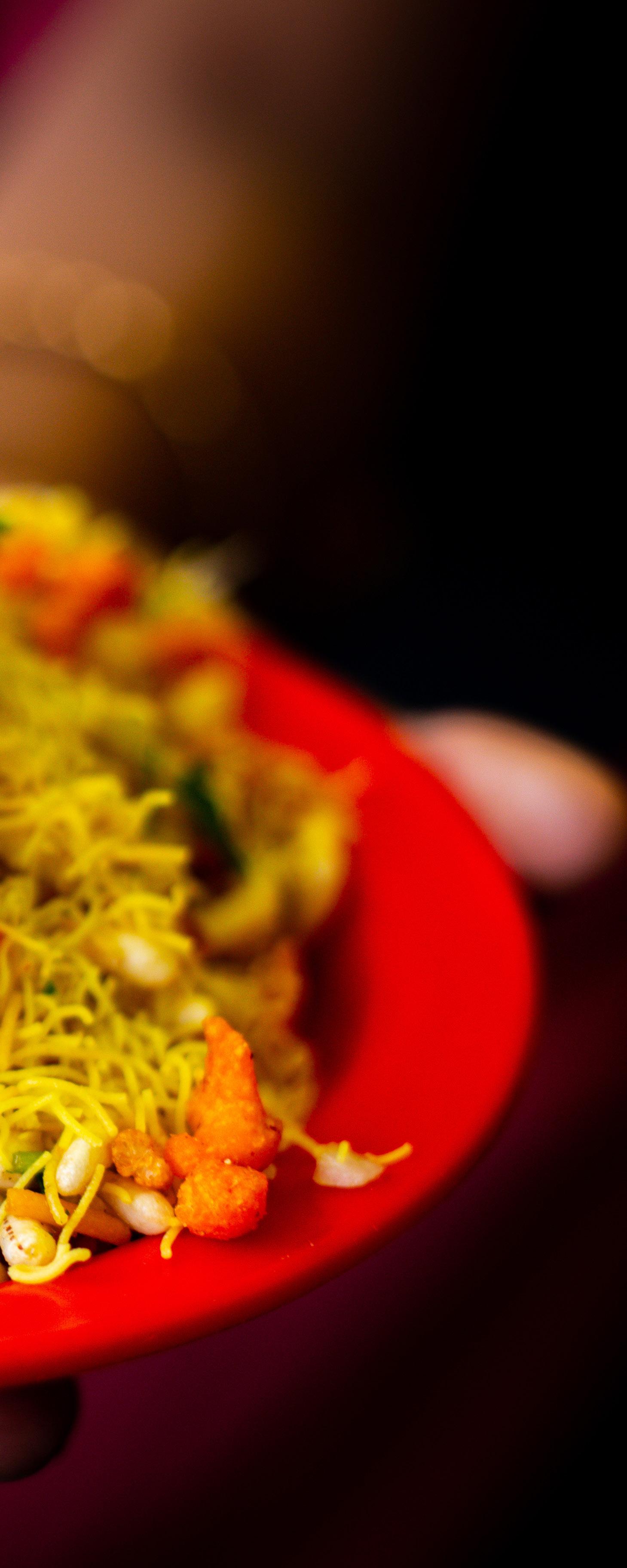
Yield: 4 portions
Bhel Puri
• 2 cups puffed rice (Murmura)
• 1/2 cup sev (thin fried noodles made from chickpea flour)
• 1/2 cup nylon sev (thin fried noodles made from chickpea flour)
• 1/2 cup papdi (crispy, deep-fried crackers)
• 1/2 cup potatoes (boiled and diced)
• 1/2 cup chickpeas (boiled)
• 1/2 cup onions (finely chopped)
• 1/2 cup tomatoes (finely chopped)
• 1/2 cup cucumber (finely chopped)
• 1/4 cup coriander leaves (finely chopped)
• 2-3 green chilies (finely chopped)
• 1 teaspoon chaat masala
• 1/2 teaspoon red chili powder
• 1 tablespoon tamarind chutney
• 1 tablespoon green chutney
• salt (to taste)
Garnish
Lemon Wedges
In a large mixing bowl, add the puffed rice, sev, nylon sev, papdi, boiled potatoes, boiled chickpeas, onion, tomato, cucumber, coriander leaves, and green chilies. Mix well. Add chaat masala, red chili powder, tamarind chutney, green chutney, and salt. Mix well. Chef Note: Taste the mixture and adjust the seasoning as required.
Serve the Bhel Puri immediately in bowls or cones. Garnish with some more sev, nylon sev, and coriander leaves. Squeeze some lemon juice on top before serving.
When I first got off the ferry coming back from a day trip to elephant caves in Mumbai, the aroma of Vada Pav could be savored from a mile away. Vendors were giving it out to groups, who were waiting to get this delectable snack. Of course, I joined the group and wasn’t disappointed.
~ Chef Z
Yield: 6
Batter for Vada Pav
• 1 cup gram flour (besan), which is made from chickpeas
• 1/2 teaspoon turmeric powder
• 1/2 teaspoon red chili powder
• 1/2 teaspoon baking soda
• salt (to taste)
• water (as required)
Vada Pav
• oil (for frying)
• 1 teaspoon black mustard seeds
• 1 teaspoon cumin seeds
• 1/2 green chilies (finely chopped)
• 1 onion (finely chopped)
• 1 tablespoon ginger-garlic paste
• 1/2 teaspoon turmeric powder
• 1/2 teaspoon red chili powder
• 1/2 teaspoon garam masala powder salt (to taste)
• 4-5 medium-sized potatoes (boiled and mashed) and set aside
• 4-6 pav (indian bread rolls)
• butter (for toasting the pav)
Garnish
• green chutney
• tamarind chutney
Vada Pav
Heat the oil in a pan and add mustard, cumin, and green chilies. Saute for a few seconds. Add onions and sauté until they turn translucent. Add the ginger-garlic paste and saute for a minute. Add turmeric powder, red chili powder, garam masala powder, and salt. Mix well. Add the reserved mashed potatoes and mix together. Mix all the ingredients together until you achieve a loose pancake batter consistency. Cook for a few minutes. Once the mixture is cooked, turn off the heat and let it cool down.
Divide the mixture into equal-sized balls and shape them into patties. Heat oil in a deep-frying pan. Take a potato patty and dip it in the batter. Coat it well with the batter. Gently slide the coated patty into the hot oil. Fry until it turns golden brown. Remove the fried Vada from the oil and place it on a paper towel to remove the excess oil. Repeat the same process for the remaining potato patties. Chef Note: The batter for Vada Pav is now ready to use.
Cut the pav into halves and toast them on a pan with butter. Spread the green chutney and tamarind chutney on the toasted pav. Place the potato fritters inside the pav and serve hot.

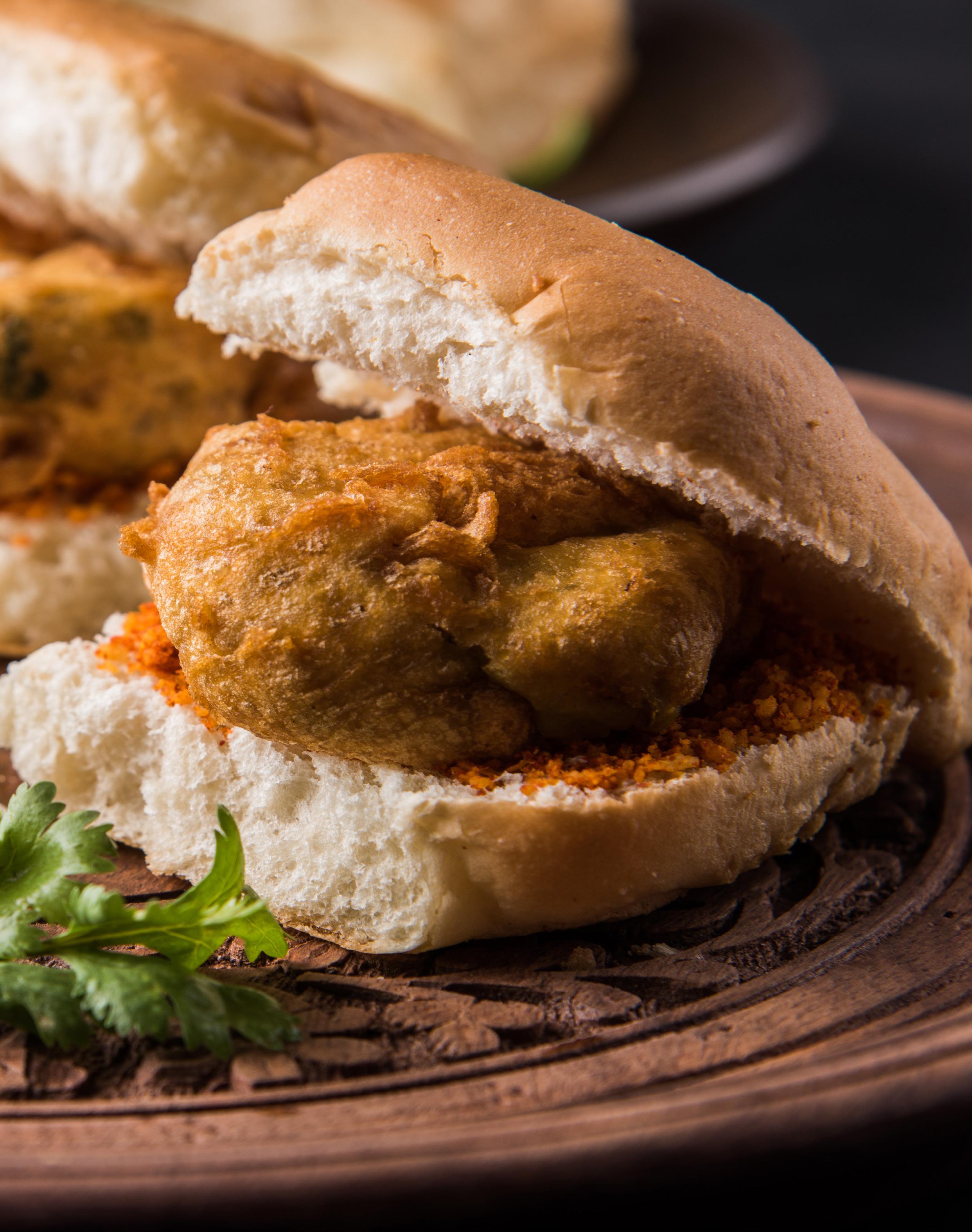
The Taste of Golf held its inaugural chef competition in 2012 with the theme “Street Food Around the World.” Chefs randomly drew the country they would represent and the protein they would prepare. Pastry Chef Nils Rowland of Ponte Vedra Inn & Club won with his single chocolate Banana Curry Truffle. Out of all the fantastic street food-themed dishes, this little chocolate nugget beat out some crazy, unique dishes.
GK: How did the event come to be at TPC
A larger venue was needed for the event to expand. Since TPC Sawgrass was already involved with the First Tee, it was a natural fit. Additionally, we were able to offer stay and play packages at the Marriott Sawgrass and the Stadium Course.
The First Tee and raising money for children are essential to this mission, and we continued to grow the event in the ensuing years. When the Pandemic hit, we all wanted to keep it going so we tapped into a creative idea to accomplish our goals during lockdown while keeping chefs and guest safe: the mystery basket.
I developed a mystery basket of ingredients (Smithfield Pork Tenderloin, black garlic, peaches, a vanilla bean, black sesame seeds, fenugreek, mustard seed, orange powder, and aleppo pepper) and delivered to each participating chef. Each had ten minutes to unpack ingredients and devise a plan to seven of the nine ingredients, with bonus points for using more. Chefs were given an hour to cook and record their cooking process. At the end of the allotted time, each chef was required to text a photo of the completed dish and then, upload a video of their preparation process.
GK: How did you get involved with the First Tee’s Taste of Golf Event?
I started with the NGCRA (National Golf Course Restaurant Association) in February 2010. Coincidentally, I had attended the first event at Epping Forrest Yacht Club in 2009 as my mom helped start the First Tee during her time at the PGA Tour. When I was approached in 2012 by the First Tee Board Members to help with the Chef portion of the Taste of Golf, I had already developed a great relationship with the Club chef community and was eager to take this on.

The future of golf is essential to the NGCRA and golf clubs— we need golfers to keep our industry alive. The First Tee is dedicated to keeping golf accessible to children.
As chef liaison, a task I undertook starting in 2011, I am responsible for finding product donations, the menu, biographies, and headshots.
While it may not have been a perfect process, we had a lot of laughs and fun. Four outstanding chefs were selected based on the video submissions.
Despite the lockdown, everyone was excited by this opportunity and the First Tee Facebook Live announcement was well received. Chef Erik Osol of the Ponte Vedra Inn and Club came in 1st place, and Chef Lewis Walker from Timuquana Country Club came in 2nd. The judges were Chef Jason Hall, CMC, Chef Jason Valerio, Chef Sam Brod, and Chef Gerald Ford, CMC.
In 2021, since we were not entirely out of lockdown, we held a culinary contest to complement the golf tournament, tapping into a totally Southern concept, Pimento Cheese. There were very few criteria, only that Pimento Cheese had to be an ingredient in the recipe. The results and creativity were out of this world from a simple Pimento Cheese Spread with housemade kimchi and focaccia toasts to Lobster Ravioli!
1.
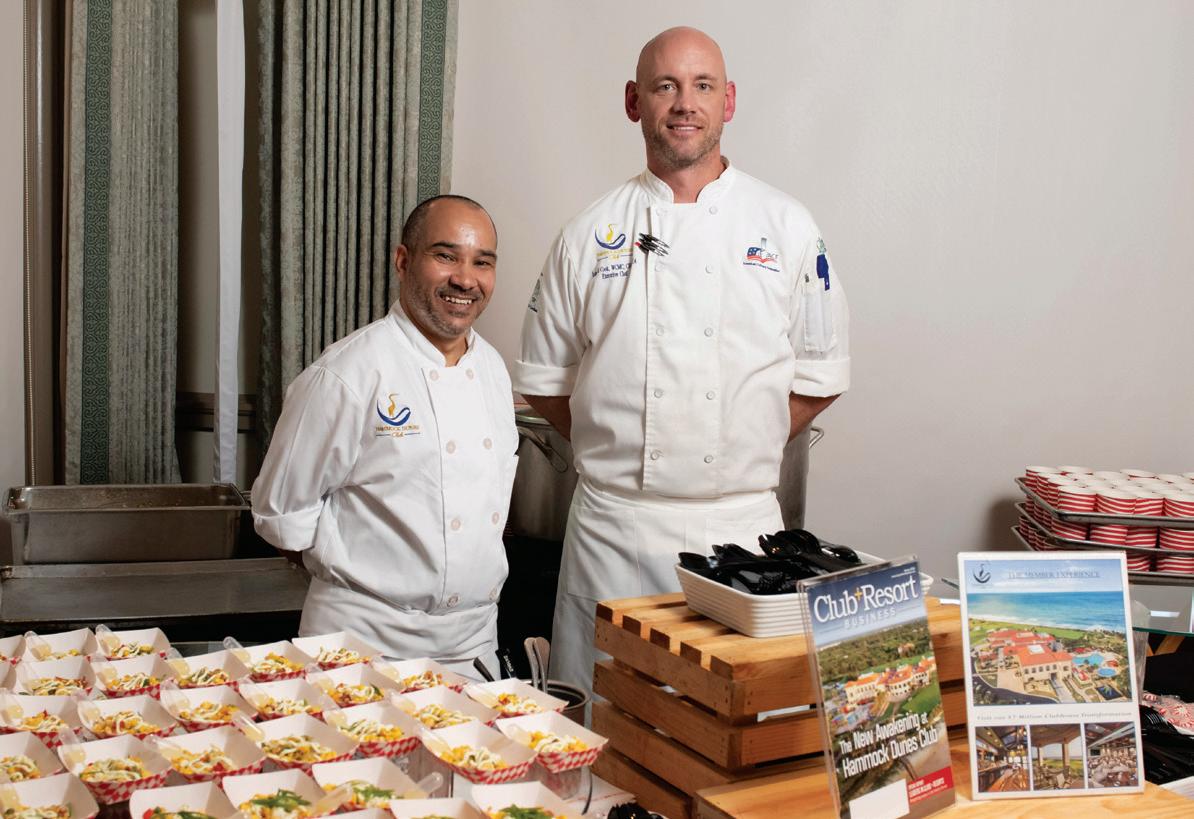

 2.
3.
5.
4.
2.
3.
5.
4.
GK: Who were the winners, and what did they make with Pimento Cheese?
It was a tie between the Lobster Galantine with Pimento Cheese Ravioli in a White Truffle Cream by Chef Lewis Walker from Timuquana Country Club and an Aji Amarillo and Pimento Stuffed Lamb Burger on a Russian Black Olive Bun by Chef de Cuisine Michael Cowan of TPC Sawgrass. We set-up a voting station on the golf course, using just their Pimento Cheese Spread on Texas Toast. Ultimately, TPC Sawgrass won by a single vote.
In 2022 we got right back into it and let the chefs fully express their pent-up creativity. Every dish was unique! Chef Tim Turner of Epping Forest Yacht Club won for his Creekstone Farms Veal Cheeks with Celery Root Coulis, Fingerling Potato Crisp, Heirloom Tomato Relish and Palm Valley Radish Sprouts.
GK: Tell us about this year’s event.
The 2023 theme was The Greatest Showman/ Upscale Circus. We had been through so many restrictions, that we were craving a festive, carnival atmosphere. Each dish had to be a few bites in a disposable dish that didn’t require more than a fork or a spoon to eat while standing. The clubs embraced this criteria and it resulted in another spectacular evening!
This year there were three award categories: Chefs’ Choice (all competing chefs voted on dishes created by their peers, Judges’ Choice (a blind tasting of all the dishes) and Best Decorated Table. Michael Meuse of Sawgrass Country Club won both food awards, while Executive Chef Joe Gianzero of Jacksonville Golf and Country Club impressed with his themed table decor.
GK: Tell us your plans for the Taste of Golf in the next few years.
I would love to hold more of these tasting events. While planning and running a special event of this magnitude is
not an easy task, hearing the buzz from the attendees and their excitement over the excellent food quality makes it all worthwhile, as does of course, supporting such a worthy cause. And, seeing the anticipation surrounding the trophy ceremony really provides a great forum to the chefs to be judged by the attendees and their fellow culinarians.
by Diana DeLuciaSous Chef, Executive Chef Joe Gianzero, William Manigault, Director of Food and Beverage, Jessica Morgan, Activities and Aquatics Director, Executive Chef, Cameron Walton, The Lodge & Club, Executive Sous Chef, Xavier Santiago, Ponte Vedra Inn & Club, Dale Serverson Sous Chef, Ponte Vedra Inn & Club, Hermann Muller, Executive Chef, Ponte Vedra Inn & Club, Ashley Tombrink, Food and Beverage Captain, David Knight, Sous Chef, Ponte Vedra Inn & Club
3. St. Johns Golf and Country Club, Left to right: Beth Chambers, Director of Sales, Executive Chef, Alexander Sapp, Jessica Hurckes, Events Manager, Janelle Zenner, Communications
4. Hammock Dunes Club, Left to right: Abderrahim “Mario” Trai, Sous Chef, Executive Chef, Lance Cook
5. Shrimp Arepas with Truffle Aioli, Mayport Shrimp, Handmade Corn Flour Arepas, Mushroom and Asparagus Duxelle, and Charred Corn
6. TPC Sawgrass, Left to right: Abby Consoer, F&B Manager, Omari Lewis , Banquet Chef, Haley Johns, Cook, Executive Chef, Matt Voskuil
7. Ponte Vedra Inn & Club, and The Lodge & Club. Left to right: Stacy Neal , Chef de Partie, The Lodge & Club, Rita Santos, Chef de Partie, The Lodge & Club, Executive Chef, Cameron Walton, The Lodge & Club, Executive Sous Chef, Xavier Santiago, Ponte Vedra Inn & Club, Dale Serverson, Sous Chef, Ponte Vedra Inn & Club, Hermann Muller, Executive Chef, Ponte Vedra Inn & Club, Ashley Tombrink, Food and Beverage Captain, David Knight, Sous Chef, Ponte Vedra Inn & Club
9. Left to right: Elvin Ocasio, Cook, Sawgrass Country Club, Nicky Sparrow Moreland, 2023 Event Chair & Board Member, Tory Eulenfeld, Executive Chef, Michael Meuse, Sawgrass Country Club, Ryan Pinkard, Sous Chef, Sawgrass Country Club, Alexandra Hogan, Executive Sous Chef, Sawgrass Country Club
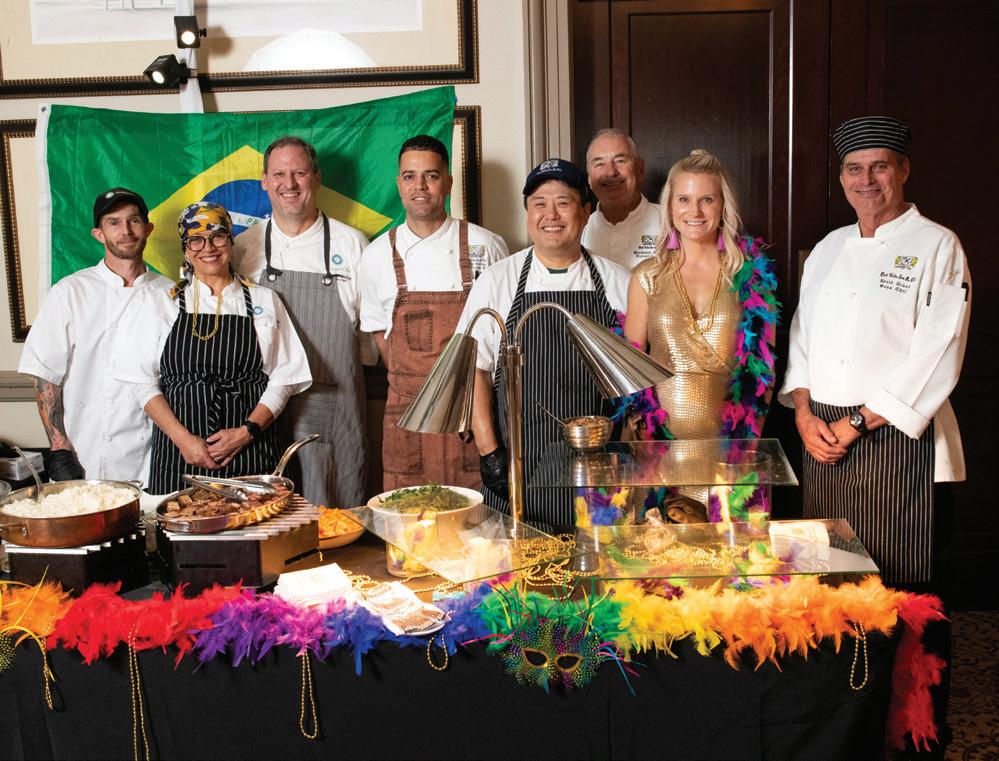
10. World Golf Village, Left to right: Daryl Duitama, Line Cook, Executive Chef, Tiago Joaquim, Lucia Carvajal, Lead Cook
 1. Taste of Golf Judges, Left to right: Executive Chef Stephen Bechan from the Florida Yacht Club, Tory Eulenfeld, Chef Liaison for the Taste of Golf and National Director of NGCRA, Chef Jason D. Hall, CMC, Vice President of Research and Culinary Development for the Crown Steam Group and Southbend
2. Jacksonville Golf and Country Club, Left to right: Hans Grover, General Manager, Ninai Palmore,
8. The Taste of Golf 2023 team celebrate
6.
7.
1. Taste of Golf Judges, Left to right: Executive Chef Stephen Bechan from the Florida Yacht Club, Tory Eulenfeld, Chef Liaison for the Taste of Golf and National Director of NGCRA, Chef Jason D. Hall, CMC, Vice President of Research and Culinary Development for the Crown Steam Group and Southbend
2. Jacksonville Golf and Country Club, Left to right: Hans Grover, General Manager, Ninai Palmore,
8. The Taste of Golf 2023 team celebrate
6.
7.
Participating chefs:
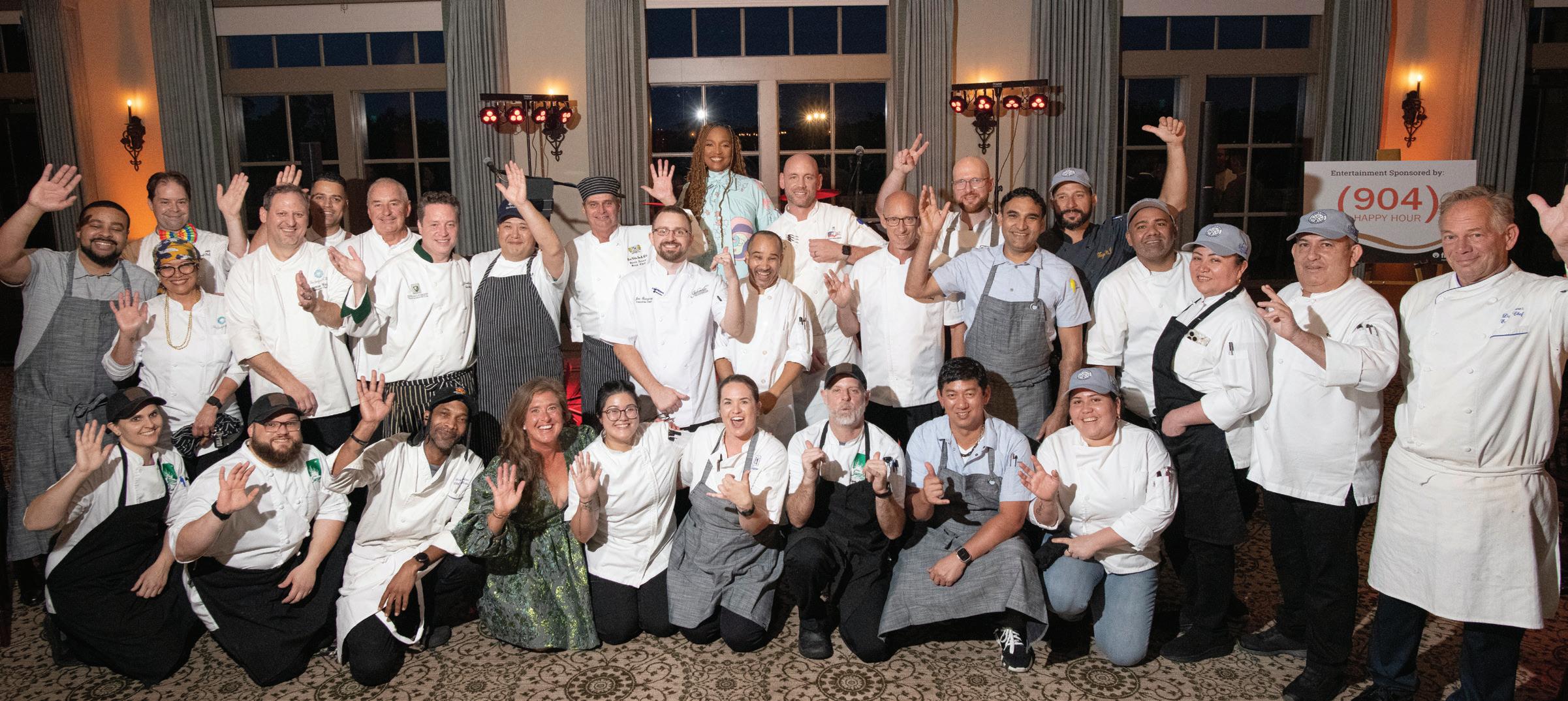
Executive Chef Matt Voskuil, Nineteen at TPC Sawgrass, Foie Gras Mousse with Strawberry, Brioche, Almond.
Executive Chef Lance Cook, Hammock Dunes Club, Cheese Ale Soup, Carnival Pretzel Croutons, Club Made Worcestershire Powder Mexican Street Corn Blend with Chipotle Agave Pork Belly, Cilantro Creme and Lime Juice Pipette.
Executive Chef Michael Meuse, Sawgrass Country Club, Thai Cashew and Sriracha Donut with Poke Tuna Crunch with Masago, Radish Sprouts, Cucumber and Scallions.
Executive Chef Joe Gianzero, Jacksonville Golf & Country Club, Walking Taco with Braised Short Rib Cotija Cheese, and pickled onion.
Executive Chef Alexander Sapp, St. Johns Golf & Country Club, Roasted Chicken Leg & Duck Confit with Funnel Cake Bread Pudding, Kettle Corn Lace Cookies and Cotton Candy Cake Truffles.

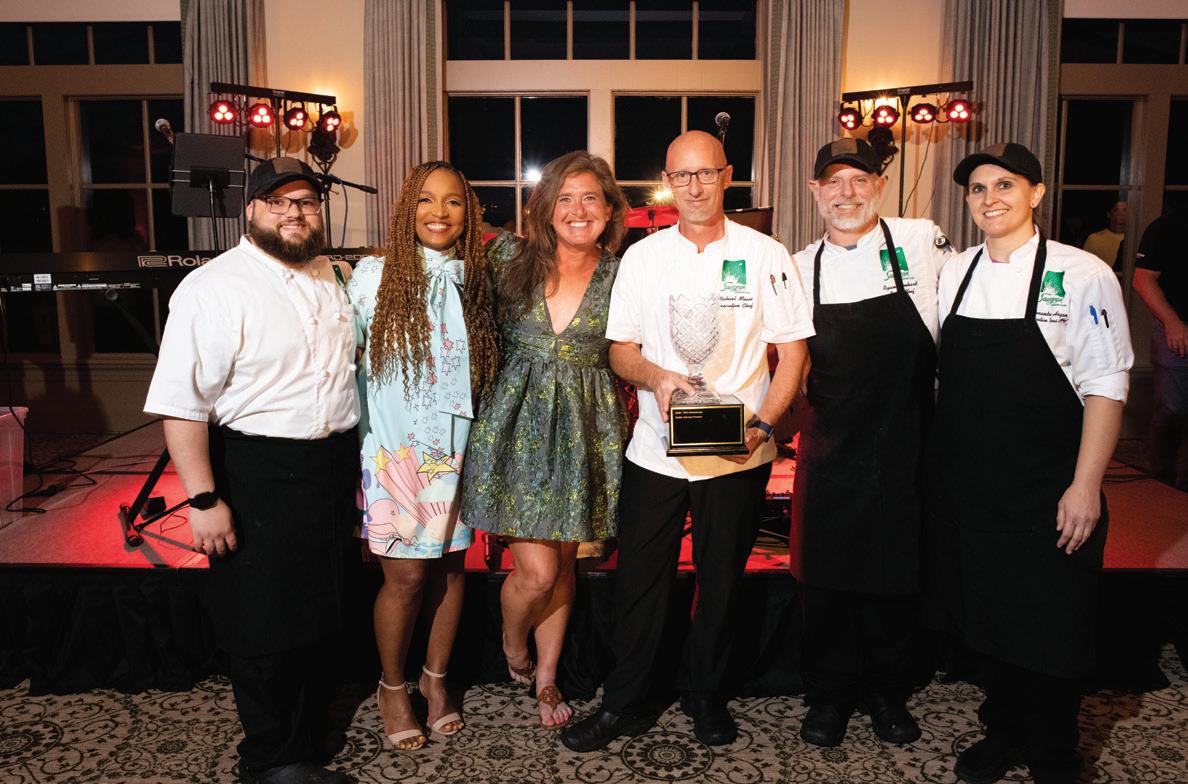
Chef Director Eric Butcher, PGA Tour, Global Home, Lamb Shawarma with Fresh Pita, Tabboulleh, Labneh, Pickled Vegetables Sesame and Aleppo Caramel Corn.
Executive Chef Darek Stennes, The River Club and Executive Chef Tim Turner, Epping Forest Yacht & Country Club, Cheerwine Char Sui Pork Bao Buns with Kimchi Popcorn.
Executive Chef Tiago Joaquim, World Golf Village, Porcini Dusted Shrimp Arepas with Truffle Aioli, Mayport Shrimp, Handmade Corn Flour Arepas, Mushroom and Asparagus Duxelle and Charred Corn.
Executive Chef Cameron Walton, The Lodge & Club & Executive Sous Chef Xavier Santiago, Ponte Vedra Inn & Club, Gaucho Style Wagyu Short Ribs with Feijoada, Roasted Garlic Rice and Pickled Onion Herb Sauce.
8. 9. 10.Executive Chef Michael Meuse, Sawgrass Country Club won this year’s competition with his creation of Thai Cashew and Sriracha Donut with Poke Tuna Crunch.
In late 2017, my family decided to move back to my hometown of Ponte Vedra and I was fortunate to land a job as Executive Chef at Sawgrass Country Club. As the new kid in a crowded culinary market, I felt the need to prove myself among all the talent in the marketplace. My first event was the 2018 Taste of Golf, which coincidentally was my first year at Sawgrass Country Club. I wanted to present a dish that could display our club’s talents and took the win with Braised Short Rib with Manchego Polenta. My team and I were so proud to receive this recognition. I was inspired by this year’s Carnival and Circus theme, transporting me back to the idea of a state fair, which attendees are drawn by the unique and unconventional foods that are often the forerunners of new trends.
A State Fair is rich with fusion cuisine, and this blended culinary style has always been a passion. My personal style is “farmhouse fusion,” heavily influenced by cultural diversity from my southern roots. From sweet to spicy and salty to tangy, Asian dishes, rich with beautiful and complex flavors, have always been my go-to when creating something new. Drawing on those flavors, I knew that a Thai-inspired “Sriracha Donut,” could be a new twist on a classic combination of ingredients, all served on the perfect vessel: the donut.
Developing the dish was a challenge, like most things in the kitchen. To bring the dish to life, I knew I would have a “sushi roll” inspired creation that needed the proper texture and taste. The donuts were crowned with sesame seeds to emulate the exterior of a “sushi roll,” adding a nutty taste and familiar texture. For richness, I substituted coconut milk for whole milk in the batter, leveling the texture and adding flavor. Roasted nori sushi seaweed balanced the sweetness of the coconut milk and sugars. Bonzai spice, provided by a local purveyor, elevated the taste with umami flavors such as pineapple, seaweed, and soy.
Once the donut was perfected, I moved on to tackling the crunch element. I chose a fried tempura Furikake crunch to balance the tuna poke’s natural sweetness. High-quality, fresh Ahi tuna, cucumber, kabayaki sauce, kewpie mayo, scallions, all topped with briny pops of masago and micro radish sprouts became the core. The sriracha glaze was the ribbon to tie the whole dish together, holding the
cashews in place while not overpowering the dish with heat. I am proud to say that we are the first team to win Chef’s Choice and the Overall Champion awards in the 14 years of the Taste of Golf. But most of all, we are honored to help kids on their First Tee journeys and are privileged to be invited back for the 2024 edition. ~ by Michael Meuse
Yields: 10-12
Thai Donuts
• neutral flavor pan spray (of your choice)
• 4 tablespoons black and white sesame seeds (mixed)
• 2 cups all-purpose flour
• 11/2 cups sugar
• 2 teaspoons baking powder
• 11/2 teaspoons Saturiwa Trading Co. banzai spice
• 1/2 teaspoon kosher salt
• 1 extra large egg (beaten lightly)
• 11/4 cup full fat coconut milk
• 2 tablespoons salted butter(melted)
• 11/2 teaspoons pure vanilla extract
• 1 sheet sushi nori seaweed (shredded)
Toppings
Sriracha Glaze with Cashews
• 1 tablespoon sriracha sauce
• 1 tablespoon confectioners’ sugar
• 1 cup sweet Thai chili sauce
• 1 cup cashews or peanuts (toasted, salted, and chopped)
Tuna Poke Crunch
Poke
• 1/2 pound sushi grade Ahi Tuna (diced)
• 1 small English cucumber (diced)
• 1 bunch scallions (bias cut)
• 1 tablespoon Saturiwa Trading Co. furikake nori fumi spice
• 1 teaspoon Saturiwa Trading Co. banzai Spice
• 4 ounces kabayaki sauce
• 2 ounces kewpie mayo
• 4 ounces red and green masago (reserve 1/2 red and all green for topping)
• 1 pint radish sprouts (trimmed for garnish)

Crunch
• 1 cup vegetable fry oil or peanut oil
• 1 cup tempura batter (any standard recipe, not too thick)
• 1 1/2 teaspoons Saturiwa Trading Co. furikake nori fumi spice
Donuts
Preheat the oven to 350°F. Use a nonstick spray on a silicone 3” donut pan (12 cavities) and sprinkle a teaspoon of the mixed sesame seeds into each cavity. Mix the flour, sugar, baking powder, banzai spice, and salt in a large bowl. Whisk together the egg, coconut milk, melted butter, and vanilla in a small bowl. Stir the wet mixture into the dry ingredients until combined, then fold in the shredded nori seaweed last to incorporate. Fill a pastry bag with the batter and slowly fill the baking pans, filling each one no more than 3/4 full. Bake for 13-15 minutes until a toothpick comes out clean. Allow to cool for five minutes, then tap the donuts onto a sheet pan sesame seed side up.

Combine the sriracha, sugar, and sweet chili sauce in a shallow bowl. Dip each donut “sesame top” into the sriracha glaze, then place back onto your sheet pan, lightly garnish with the chopped nuts, and allow to cool and set. Chef Note: Now it is time to make the Tuna Poke Crunch.

Crunch
Preheat a deep sauté pan with oil to 350°F. Drizzle half of the tempura batter into hot oil in a circular motion keeping the crunch diameter smaller. Chef Note: Use caution; it will be reactive! Use a skimmer spoon to stir for 30-45 seconds. Once it is a toast color, remove and drain most of the oil. Chef Note: Gently spread it out on a draining tray with a towel. Use a towel to help absorb cooking oils from the crunch preparation. This will help with the incorporation of the spices while rolling the crunch back and forth. While the crunch is hot, season with the Furikake spice mix and use a towel to roll and incorporate.
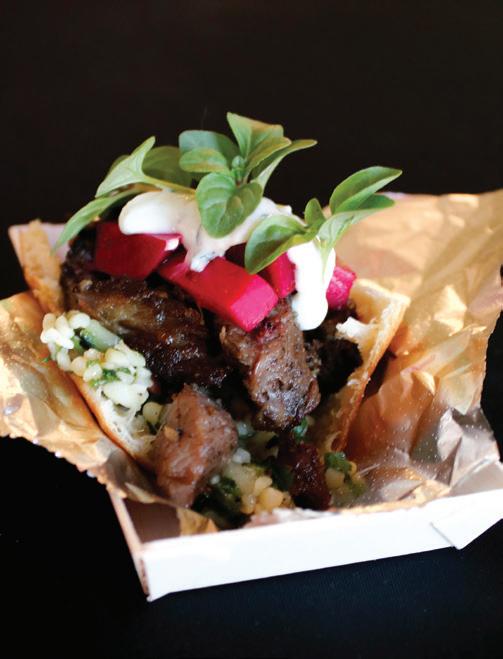

Mix the tuna, cucumber, scallions, Furikake and Banzai spice, kabayaki, kewpie sauces, and half of the red masago into a large bowl. Gently incorporate, cover, and reserve in the refrigerator for 20 minutes.
To assemble your donut, leave the donuts on the sheet pan, place two ounces of the poke tuna mix atop each donut, and gently depress the center. Next, nest the top of the poke using a teaspoon with your tempura crunch. To finish decorating, place a pearl-sized ball of each masago and two or three radish sprouts on top using a small, tipped spoon or butter knife. Select your serving vessel and transfer carefully not to disrupt the toppings.

 Foie gras mousse with strawberry, brioche, almond
Foie gras mousse with strawberry, brioche, almond
 Walking taco with braised short rib, cotija cheese, and pickled onion
Walking taco with braised short rib, cotija cheese, and pickled onion

Yield: One
2 ounces Mount Gay Rum
4 ounces Southside Mix (recipe below)
Club Soda
Garnish
Mint Sprig (freshly picked)
Southside Mix
Yield: 1 gallon (save for future cocktails)
1 quart of Mint Leaves (freshly picked)
1 pint of Sugar
1 quart of Lemon Juice
Southside Mix
Blend the mint leaves, sugar, and lemon juice in a one-gallon container. Top it off with water. Shake until well mixed. Keep refrigerated until needed.
In a highball glass filled with ice, add the Mount Gay rum. Add the Southside mix, top with the club soda. Garnish with a sprig of mint.

Follow Golf Kitchen for Exclusive Chef Interviews, Recipe of the Week, Friday’s Cocktail and much more.


A true craftsman knows that perfection doesn’t just happen. It takes meticulous attention to detail, intense passion, and a deep commitment to the craft.
Rooted in the hardworking spirit of Chicago, Allen Brothers is a result of rolling up our sleeves and perfecting every piece of the process. From sourcing, to aging, to hand-cutting our meats — every chef knows they’re working with a level of quality that doesn’t exist elsewhere.
For decades we’ve remained a cut above — pouring pride and a human touch into everything we do. With Allen Brothers, you’re backed by unparalleled service and skill. So, when you step in the kitchen, you’re already in a class of your own.
Our materials. Your masterpiece. Crafting excellence since 1893.
